#panacea: rebirth
Explore tagged Tumblr posts
Text
It's my birthday!! 🥳 I've turned the same age as Crowe 🤭💕
It'd mean a lot if you gave my games a try (especially Petrichor, my most recent one) & a little love to my upcoming project Potion Pleasing (by reblogging the updates); the demo is coming out very soon!
Thank you!🥰


#pri rambles#prikarin games#killer trait#monochrome pixels#hummingbird's crown#petrichor#petrichor vn#panacea#panacea: rebirth#where winter crows go#potion pleasing
220 notes
·
View notes
Text
There are several historical contexts for what is going on now in Israel-Palestine that cannot be ignored. The wider historical context goes back to the mid-19th century, when evangelical Christianity in the West turned the idea of the “return of the Jews” into a religious millennial imperative and advocated the establishment of a Jewish state in Palestine as part of the steps that would lead to the resurrection of the dead, the return of the Messiah, and the end of time. Theology became policy toward the end of the 19th century and in the years leading up to World War I for two reasons. First, it worked in the interest of those in Britian wishing to dismantle the Ottoman Empire and incorporate parts of it into the British Empire. Second, it resonated with those within the British aristocracy, both Jews and Christians, who became enchanted with the idea of Zionism as a panacea for the problem of anti-Semitism in Central and Eastern Europe, which had produced an unwelcome wave of Jewish immigration to Britain. When these two interests fused, they propelled the British government to issue the famous – or infamous – Balfour Declaration in 1917. Jewish thinkers and activists who redefined Judaism as nationalism hoped this definition would protect Jewish communities from existential danger in Europe by homing in on Palestine as the desired space for “rebirth of the Jewish nation”. In the process, the cultural and intellectual Zionist project transformed into a settler colonial one – which aimed at Judaising historical Palestine, disregarding the fact that it was inhabited by an Indigenous population. In turn, the Palestinian society, quite pastoral at that time and in its early stage of modernisation and construction of a national identity, produced its own anti-colonial movement. Its first significant action against the Zionist colonisation project came with al-Buraq Uprising of 1929, and it has not ceased since then.
157 notes
·
View notes
Text
Even though the Future Redeemed DLC has all but outright stated that Panacea is the daughter of Reyn and Sharla, I honestly still want to believe that Ashera is also their daughter. Perhaps Panacea's older sister, who didn't have the luck of staying outside of the cycle of endless fighting and rebirth, or something along those lines? Because I honestly could easily see Reyn having somehow managed to convince Sharla to let him name their first child. . . which in turn somehow led Ashera down the path of idolizing Dunban and ending up like That. And then, having learned from her mistake, Sharla decided to keep the naming rights. . . while not being any better at coming up with a name herself, hence Panacea.
#xenoblade#xenoblade chronicles 3#future redeemed#future redeemed spoilers#xenoblade spoilers#xenoblade chronicles 3 future redeemed#shut up cal you fool
53 notes
·
View notes
Text
Super Villains as Queer Icons

by Ken Ham
In a recent article on the Atlantic magazine’s website, there was a culture piece that looked at horror movie villains as “queer icons.”
Without delving too deeply into the article—which included many forced associations as well as some movies which were specifically written from the LGBT perspective, the author, Mary Retta, looked at several different “movie monsters,” and one association really stood out. She quoted another author, Susan Stryker, who in 1994 said this in regard to Frankenstein’s monster: “The transsexual body is an unnatural body. It is the product of medical science. It is a technological construction. It is flesh torn apart and sewn together again in a shape other than that in which it was born.”
We’ve discussed numerous times the horrors of surgical mutilation and unnecessary hormone treatments that the transgender movement and an all-too-willing medical community have foisted upon young people who are undergoing a crisis in their lives or just the uncomfortable and tumultuous throes of puberty. Rather than looking to heal those who are hurting, this only adds to the pain and confusion of these young people. But the above “body” statement struck me as a reminder that everyone is remade in one way or another. Either we “remake” ourselves in our own fallen and distorted image by surgery, addiction, hedonism, false religion, doing what is right in our own eyes (Judges 21:25), or some other panacea which excludes God. Or as Scripture teaches, we are remade in the image of Christ.
While at first blush it may seem counterintuitive to compare human birth and Christian rebirth with Frankenstein and his monster, there are some striking parallels and contrasts. I’ll briefly list a few below, based on the “body” quote above. The Bible speaks about God “knitting” or “intricately weaving” us together in the womb (Psalm 139:13, 15). The development of the child in the womb is one of the wonders of the created world, wherein genetic material from the father and mother comes together to create a new, unique individual. Scripture rightly says that people are “fearfully and wonderfully made” (Psalm 139:14). By contrast, Victor Frankenstein crudely sewed together his monster, hindered by the constraints of his abilities and tools. The resulting abomination is rejected in disgust by his creator.
There have been tremendous advances in reconstructive surgery, where surgeons reconstruct accident victims’ bodies to resemble their pre-accident selves. Prosthetics technology also gives people artificial parts to either compensate for birth defects (a sad consequence of the fall) or loss of body parts in accidents. These are good things and can be looked at as medical science attempting to alleviate some of the consequences of mankind’s sin.
Such science is also co-opted for so-called “gender affirmative care” in which biological males receive surgery and hormones to feminize their appearance and vice versa for women. However, there is no way to truly turn a male into a female or a female into a male. A man will never have the capacity to bear and nurse offspring as a mother does, and a woman will never father children. This sad imitation of manhood or womanhood robs them of their God-given femininity or masculinity that should be healthy and honoring for them as image-bearers of God. In this sin-cursed world, however, people are often confused, connived, or coerced into believing lies about their bodies, gender, or sexuality. Recently, videos have gone viral of “de-transitioners” who, having been given “cross-sex” hormones during their teen years, look neither masculine nor feminine and now realize the preciousness of what they gave up in this confusion.
While probably not the first comparison that comes to mind when thinking of the body of Christ and its members, Mary Shelley’s Frankenstein has some curious biblical themes running throughout its pages. Whether they were entirely intentional or not is unclear (although it seems certain that many were, based on her 1831 introduction to Frankenstein). Shelly wrote the following lines to explain the moment that the monster came to life: “Frightful must it be; for supremely frightful would be the effect of any human endeavour to mock the stupendous mechanism of the Creator of the world.” Her book contains many other biblical allusions, usually antitheses to the creation account, as would be expected in a tale where man plays God in creating what Victor Frankenstein deems a “wretched monster.” Yet all these themes in the book showcase that Shelley had in mind an anti-creation horror concept embedded in her book that acknowledged the perfectness and goodness of the Genesis creation account and that man’s attempt to remake himself or attempt to instill life is futile and only leads to catastrophe. Only God can create and recreate humans (by new birth into Christ), as we are made in his image.
6 notes
·
View notes
Text
Panacea -2011
Freewrite from 2011. I remember wanting peace, and healing, from the whirlwind of thoughts in my mind. I wanted a drop of that quintessential panacea. Clarifying, healing, renewing. I wanted to know what was real and false, so I could throw the false away. To me, truth is the panacea. Even if it hurts.
june 13: panacea 2011
truth is like tonic to a tortured mind
a mind at peace like still waters
reflect a spirit clear and unbothered
further inside ineffable items dwell
the sound of a heart's joyful swell
underneath the beat pacing pulmonary prose
here lies the essence of being, seat of the soul
beside the throne of spirit, it cradles seeds
planted by the potter, we clay pots contain HE
The I AM the father whose breath animated soil
formed man, then woman from his rib unspoiled
like them our toil isn't because he chose it upon us
we suffer because our failure to recognize who really to trust
that old dragon that snake still lives in you and me
all found at some point looking in the mirror discountingly
dissaprove of the visage that was formed divinely
how dare we doubt truth, stubbornly defiantly
living up to the being that we truly are
the image of our maker, made to show all who is GOD
discconected these days are man, it shows in his ways,
acts as a bastard child with no home, no last name
following his desires, corrupted mind, all his wishes
convict him of choices lived without love, just ambition
damaged souls and crippled minds meander the crooked path
conscious thought centered around the outward, the ghosts of the past,
but worrying bout the future is just as bad as old resentments,
we keep ourselves from now, NOW, is the gift of the PRESENT
NOW is what COUNTS, we aren't promised LATER
the moments before are just memories the light shone on and faded
so if you want to stay faded, left behind as you looked back from the fight
stay ingrateful, and complain about yesterdays problems and plight
go ahead and think what happened once, is how everything from then would be
I didn't know God crowned mistakes as the lords of our destiny
wake up from that illusion, clear your vision of distortion
what is real is what's right NOW all the rest is hokus pokus
june 13: panacea 2011
focus is required to stay in the light,
devotion to the visible is lazy attempt to gain insight
even then, people are so decieved, they can't get it right
light isn't one thing and darkness a seperate other,
the two are the polar ends of one whole mother
the moments of life are the secret of the most holy place
in each instant lived, is the soul rebirthed through a race
a pilgrimage to life on this earth, pain and joy are all parts of the course
stay the distance
whether you lose or you win it, death is inevitable to all participants
all the moments of life summed up are just the first stage
which door will you enter, if your last breath were today?
the next level is eternal, we are at the end of the cycle,
the universe watching closely, either enemies or fans,
who will join the ranks of angels?
who will die fallen, forever, ever, ever, and ever again
Why is all my stuff dark? ugh
3 notes
·
View notes
Text
ALRIGHT SO I LOVE FLOWER SYMBOLISM SO MUCH
A lot of it is ingrained in quite a number of my OC's
If I remember right I always associate the lotus with her first. Yes it is a symbol of purity and that's definitely true for Kiyo's overall spirit, but it also carries another meaning that's extremely important to her and her journey - overcoming adversity. Lotuses can grow even in the murkiest of waters, and the flowers growing up and OUT of the nastiness is kinda how Kiyo's life started out and the journey she went on as the star's savior. They also symbolize rebirth and spiritual transcendence which I'd say is pretty true for being the WoL all around, especially after Endwalker
The next flower I associate with her is the Daffodil which, just like the lotus, can be another symbol of rebirth and also new beginnings. These pretty little flowers do herald in the first signs of spring afterall. The Daffodil is definitely a good one to associate with Kiyo after everything in Endwalker - she's beginning a new chapter in her life and she's been "reborn" as a bright-eyed adventurer again
Another big one for her is the red Spider Lily, though this is more in relation to her birth mother and her trauma in dealing with that. Most people know what these flowers stand for - death, bad memories, abandonment, final goodbyes... Some pretty heavy meanings for this little flower and it symbolizes how Kiyo struggled with losing her mother at such a young age and going many years without getting any sort of closure over such a devastating loss (she does eventually, don't worry)
Indirectly linked to her is the Mallow flower. I say indirectly, because this one actually symbolizes her Azem, Panacea. While the Mallow is a symbol of love and Panacea certainly has no end to that, it's also a flower meant to represent health and protection. And since Panacea was a healer before she was Azem, this flower suits her the best
Even some of Kiyo's ships have flower symbolism
Her Oboro ship is literally called "Moonflower", though it's mainly due to him sometimes being called "Oboro Moonrise" or "Oboro of the Moonlight". And Kiyo's love is the "flower" that blooms within this moonlight. Though also, a Moonflower can represent love, dreaminess, nighttime... All things that can be associated with this pair
Her Erichthonios ship (and someone who will be redacted here for spoiler reasons) is called "amarantos", which is Ancient Greek for "immortal/unfading". You know what flower partly takes after this word? The Amaranth, which is known for its blossoms being very slow to wilt, thus being associate with unfading and everlasting love. I can't go into much more detail without spoilers, but those who know should see the symbolism here
WoL QotD: Do you relate/associate any flower any flower with your WoL and if so, what does it symbolize if anything?
Follow up: What made you pick the flower?
#nancy finish the msq#oc: kiyo#oc: panacea#ship: moonflower#ship: amarantos#lore: character#this is long I'm so sorry#I just really love flower language........
125 notes
·
View notes
Text
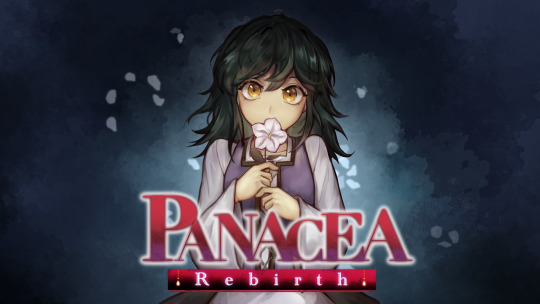

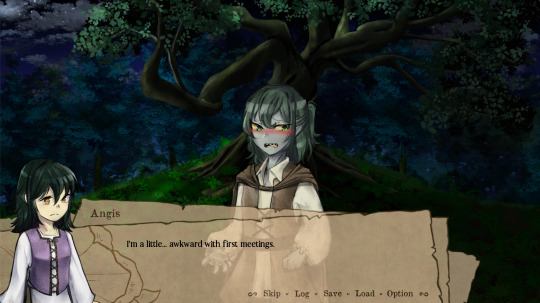
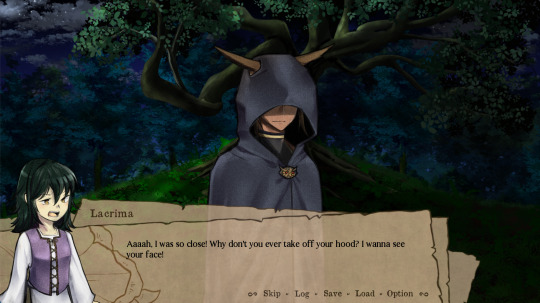
Hello everyone! We just released our next visual novel game "Panacea : Rebirth" It's our submission for Spooktober VN Jam 2022 Theme: Mystery, Horror, Dark Fantasy and Romance.
"On the outskirts of a small village, a sickly girl explores the forest in secret day after day. Are the creatures from the woods as dangerous as the rumors claim?"
❀ ❀ ❀
In a small village called Amber Stone, right on the outskirts of the Dark Forest, where it's rumored to be lurking with dangerous creatures, a sickly young girl named Lacrima lives together with her family.
As alchemists, Lacrima's parents are constantly working on their potions and medicine for the village, which she'd like to help them with but she always receives the same answer: 'you need to rest'.
Bored and lonely, Lacrima seeks comfort and adventure in her regular visits to the Dark Forest, where she meets her friend Nox, a mysterious owl creature, and Angis, a non-human alchemist boy who is prone to blushing.
One day, Lacrima overhears her parents talking about an essential ingredient needed for their potions: the moonflower, a plant that only blooms in the Dark Forest during full moon nights.
Determined to mend her relationship with her parents, Lacrima slips out on the night of the full moon in search of the rare flower.
Link to download (Free): https://fablenovel.itch.io/panacea-rebirth
#visual novel#mystery#panacea rebirth#anime#indie game#horror#pc games#gaming#art#fable novel#indiedev#dark fantasy#fantasy#romance#narrative game#female protagonist#game#free game download
19 notes
·
View notes
Text
Thrifty Gaming: Games That Won’t Blow Your Budget #112
Thrifty Gaming: Games That Won’t Blow Your Budget #112

View On WordPress
10 notes
·
View notes
Text
It’s my birthday~
Today, June 28th, is my birthday!!
I'm Pri, a gamedev who loves storytelling & has written a few free games (some are demos). It'd mean a lot if you gave them a try & gave a little love to my upcoming project Potion Pleasing (by reblogging the updates). Thank you!

Panacea: Rebirth

Where Winter Crows Go
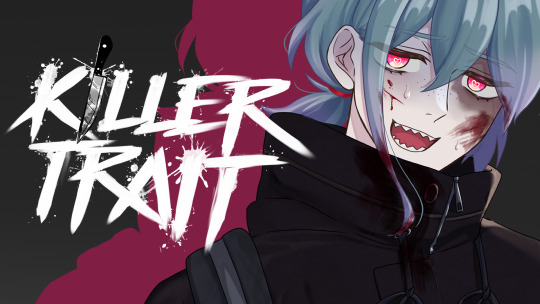
Killer Trait
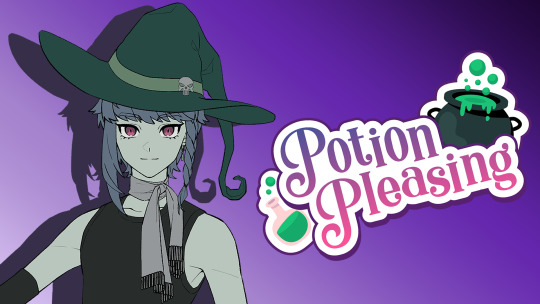
Potion Pleasing (no release yet but you can follow the updates with the Potion Pleasing tag <3)
116 notes
·
View notes
Text
death is innately tied to birth in the original aeldari conception. before She Who Thirsts, an aeldari who died would be reborn with memories of their past life. Ynnead is this concept made manifest. yvraine doesn't resurrect people because she has powers over death, she resurrects people because she also has powers of rebirth.
and because Ynnead is a god, this power extends beyond the death and resurrection of mere mortals. perhaps all aeldari must die before Chaos can be defeated. perhaps rhana dandra will destroy materium and immaterium alike. but Ynnead is the god of life in death. so as the aeldari die, so too will they be reborn. so as the universe burns, so too will it be rebuilt. the final joke is not on slaanesh, but on all of chaos, a punchline so closely guarded that even the harlequins don't know the full of it.
as fuegan falls, ahriman in his reckless desperation to fix all his failures casts his final spell, a spell written to be the panacea to all ills, a spell stolen from the depths of the black library. it works. it works by destroying everything, so nothing is left to be broken. the materium collapses to dust. the countless dead flood the sea of souls--not just the milky way, the whole universe--unleashing catastrophic tempests that batter even the gods down to nothing. and as the storms fade so too does the empyrean itself, for without the bright souls of the materium to feed it the immaterium cannot exist.
but Ynnead is the god of rebirth. the immense energies unleashed by the destruction of all do not go to waste. they fuel the fires of creation. a new universe is born, materium and immaterium alike, unscarred by the endless wars of yesteryear. a new milky way turns in the sky, and within it, a new aeldari people free from the thirsts of sai'lanthresh.
yeah so that's how the roadtrip fic ends
Talking about the whole "the Chaos Gods are a countdown to the Warp getting reset" and I came up with an idea.
So! Ahriman FINALLY succeeds at becoming a Chaos God, he's now going to be able to fix the Rubric once and for all! He did it!
His number was one.
The Warp immediately implodes.
All (and I mean all) is dust.
47 notes
·
View notes
Text
A Dictionary of Alchemical Symbols
I was super flattered by all the positive comments and tags on my post about FMA:B’s alchemical symbolism. People seemed interested in learning more about alchemy, so I thought I’d post this here. This list is mostly paraphrased from A Dictionary of Alchemical Imagery by Lyndy Abraham, which is my main source. Brace yourselves, this will be long. (Disclaimer: The names and order of alchemical processes changes depending on the source. It’s a cyclical process, not a linear process. So I’m guessing at the order of the procedures.)
Abyss: Another name for Prima Materia, Chaos or the formless primordial matter from which the Stone is made.
Air: The androgynous, volatile, combined masculine and feminine principles. Its properties are hot and wet.
Alabaster: The White Stone, the material at the second stage of the work that can transmute metals into silver. It is purified and spiritual matter, body and soul (but not spirit yet).
Amber: Considered synonymous with gold, the product of the philosophical tree that represents the Philosopher’s Stone.
Androgyne: Mercurius and the Philosopher’s Stone, a union of male and female principles (i.e. Sun and Moon, sulfur and mercury, red and white), It is a synthesis of the hot, dry male aspect and the cold, wet female aspect. It represents the integration of male and female energies. It is therefore a union of opposites and a perfect being. It is sometimes represented by (red) roses and (white) lilies, which are symbols of the Red and White Tinctures. The symbol for Mercury (the planet) contains the symbols for both the sun and the moon, making it hermaphroditic. (Also called a rebis.)
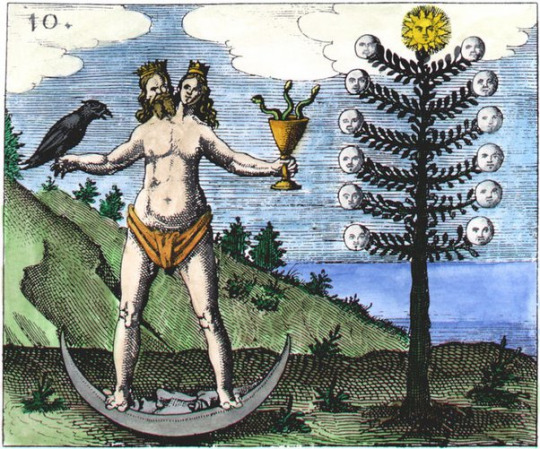
From Rosarium Philosophorum, redesigned by Johann Daniel Mylius
Angel: The volatile, spiritual, subtle matter of the Stone during sublimation.
Antimony: The substance of the Stone during the nigredo, black earth, the next stage up from lead.
Apollo: Represents the Red Tincture. The masculine principle, hot and dry, the rubedo stage.
Apple: The golden apple represents the fixing power of Sulphur on the elusive Mercury (represented by Atalanta).
Aqua ardens: “Burning water,” the universal solvent that dissolves matter into prima materia. Represented by Mercury.
Aqua regia: “Royal water,” a mixture of nitric acid and hydrochloric acid (sal ammoniac) that can dissolve gold and platinum. That makes it a form of the mercurial “burning water” that can reduce all metal to prima materia.
Aqua vitae: Ethanol, specifically distilled wine. It’s also a name for Mercury and for Quintessence, the catalyst of the work that “washes” the matter of the Stone to purify and whiten it. It’s the “water of life” that resurrects the dead matter, the essence of love and forgiveness.
Argent vive: Quicksilver, actual mercury (Hg), the feminine “seed” of metals that must be “married” to its masculine counterpart, sulfur.
Ash: The remains of the body when the subtle self (the soul) is removed during calcination. It is the white powder that the body becomes during the white stage, which is washed in mercurial water and tempered with fire. A phoenix rises from the ashes.
Autumn: The completion of the Great Work is symbolized by the philosophical tree bearing its gold and silver fruit. Trees bear fruit in autumn, making autumn the season of culmination.
Balm: A term for the Philosopher’s Stone in the form of a panacea, a medicine that can purify anything and cure any disease (including spiritual ones)
Basilisk: Mercury in its negative aspect, it represents endless hunger and self-absorption. It is the mercurial water in its destructive aspect, which “kills” base metal, reducing it to prima materia.
Bath: The mercurial waters of purification, which dissolves, cleanses, and resurrects the matter of the Stone. The breaking down and washing away of an old state of being, leading to rebirth; baptism.
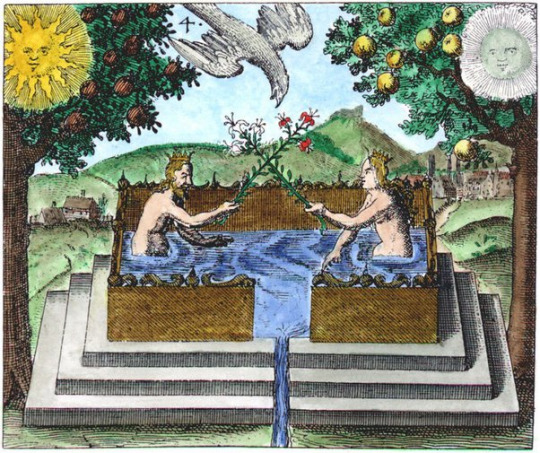
From Philosophia Reformata by Johann Daniel Mylius
Battles: Between a god and a dragon, or two dragons, or an eagle and a snake, a lion and a winged lioness, or similar; represent the alchemical lovers (Sol and Luna) in their impure state, as the “quarrelling couple.” Their fighting represents the violent chemical reactions that result of trying to force together the opposing forces of sulfur and mercury (or of the four elements), but eventually they reconcile and are married.

By Johann Daniel Mylius
Bed: The alchemical vessel during the “chemical wedding” stage.
Bee: Another symbol of the “mercurial serpent,” universal solvent. Its sting is a version of “killing” metals, destroying the old state of being. (Bees also transmute base matter in their process of creating honey.)
Beheading: The dismemberment of the King, the dissolution stage, leading to putrefaction and nigredo. It frees the soul from the body, so it can gain spiritual understanding. (The 8th engraving in The Ninth Gate.)
Binding: Binding Mercurius with cords represents fixation of the volatile, controlling the elusive and wily spirit of Mercurius so that he will help the alchemist. Nailing a serpent to a cross means the same thing.
Birds (flying): Represent volatile substances—vapors, fumes, spirits, souls, rising to the top of the alembic and falling as rain during the ablution stage.
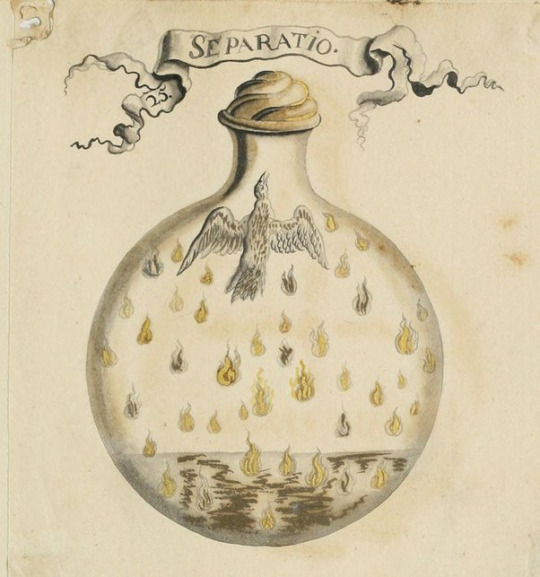
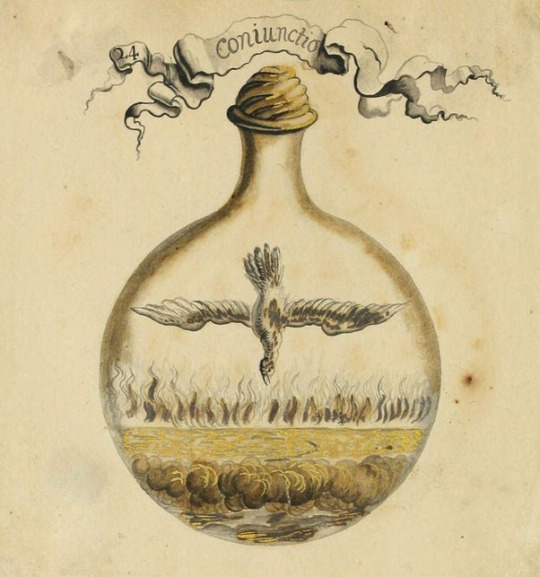
From The Crowning of Nature
Birds of Prey: The “amorous” birds of prey are a particularly violent symbol of the Chemical Wedding, the uniting of substances. They simultaneously copulate and cannibalize each other. Consumption represents taking the essence of the consumed into oneself, such as in communion or in the ouroboros symbol.
Bird of Hermes: A symbol of the Philosopher’s Stone, which must be hatched from an egg produced by the Chemical Wedding, raised, and tamed. It eats its own wings, representing the fixation of the volatile (i.e. it can no longer fly upwards). Its blood is the Elixir of Life.
Black: The nigredo, the death of the old state of being and the mortification of the body that paves the way for renewal and resurrection. The matter of the Stone during the nigredo is called “black earth,” and it lies at the bottom of the alembic. The soul descends into the Underworld and experiences the Dark Night of the Soul, and all the difficulty and pain that come with it. Symbolized by the crow or raven, the grave or tomb, the eclipse, beheading, coal, lead, and Saturn.
Blood: A symbol of the Red Tincture, the Philosopher’s Stone. If a “pure” being sheds blood, it cleanses “impure” beings of corruption. It is also the mercurial water that washes the matter of the Stone during ablution. The blood of the Green Lion nourishes the Stone during cibation. Staining white sheets with red blood (i.e. as in the loss of virginity, the gaining of sexual maturity) represents the rubedo following albedo.
Bronze/Brass: Both represent “white gold” (gold + silver), the raw matter of the Stone which must be cleansed of impurities. Identified with Latona (Leto), the mother of Apollo and Artemis (i.e. the sun and moon), and also with the Green Lion. It must have its “stains” washed away to become Gold and Silver (respectively).
Caduceus: The wand of Hermes, symbolizing the circulation of male and female energies (the serpents), and their reconciliation. The wand unifies them, and they entwine around it. Harmonizing unification of all opposites.
Calcination: Stage One. Heating the base metal to ash. This represents removing all the surface qualities of the self, putting oneself through “purifying fires” until one is reduced to prima materia. Self-judgement, acknowledging that you are not perfect, with a desire and determination to do better. Burn away the old self.
Castle: The alchemical vessel, sealed to prevent the substance of the Stone from being contaminated by outside forces, and to keep the volatile part from escaping. Its towers represent the athanor (furnace). The castle can also represent “impure” matter (i.e. the Green Lion, Latona). Also represents withdrawing to the inner self.
Chaos: The formless matter from which the world was made, the mass of prima materia at the beginning of the universe that contains all things, and from which all things come. The extremely dense ball of matter that was the universe until the Big Bang. Chaos is separated into the Four Elements, which are then united with each other in harmony.
Chariot of Phaethon: A name for the Great Work. This is because the Opus is cyclical like the wheels of a chariot and the sun’s course through the heavens. When Phaethon dies, Helios mourns in the form of an eclipse, representing the nigredo.
Chemical Wedding: The image of lovers, usually a king and queen representing the sun and moon, being married or having sex. One of the most important parts of the Work, the unification of opposites — sulfur and mercury, male and female, sun and moon, hot and cold, dry and moist, fixed and volatile, body and spirit. The lovers are wedded by Mercurius, the mediating principle who binds them together. The chemical wedding happens multiple times, becoming more “purified” each time – it begins as animals mating, and ends as the noble royal wedding of the King and Queen. The resulting Stone is the essence of pure divine love. Coagula is always followed by solve again, so often the lovers are shown in a coffin or grave, because the nigredo follows the chemical wedding. After that happens, soul and spirit unite in the albedo stage, and then they reunite with the now washed and purified body in the rubedo stage. Body dissolves into spirit, spirit coagulates into matter. Therefore, the knowledge gained from union with spirit (God) can be actively applied and made manifest in the physical world.
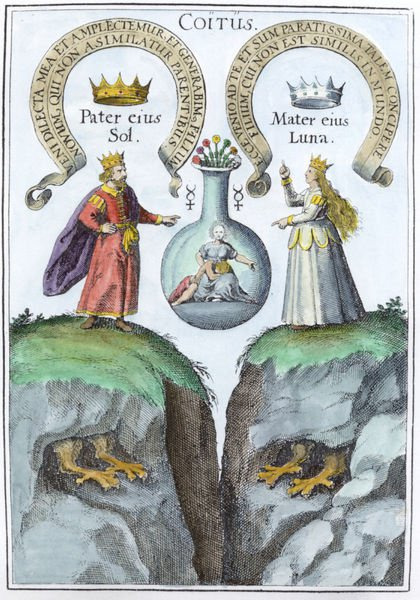
By Johann Daniel Mylius
Child: The Philosopher’s Stone when it is born from the chemical wedding of the Sun and Moon. He gestates in the belly of the wind, i.e. the soul in the volatile state. When he is brought to Earth and nourished, he grows up to be a spiritual tour-de-force that can raise the vibration of anything.
Child’s play: Another metaphor for the Opus, because the process is subversive, and because it’s stupidly simple once you actually understand how it works. The Opus is compared to making mud pies by pouring water on dust and then making “solid” objects with the resulting mud.
Cibation: Stage Seven. The newborn Stone is “fed” the White and Red Tincture, “milk and meat,” which are added to the vessel to re-infuse the Stone with life energy.
Cinnabar: Mercury sulfide (ore), which is bright red. Represents the color of the Stone in the final stages.
Circle: Perfection and eternity, the spiritual realm, the completed Work. With a dot in the center, it symbolizes gold.
Cloud: The vapor that rises to the top of the vessel during sublimation, the volatile state. The cloud is dark and made of argent vive (quicksilver), eclipsing the sun. During distillation, the cloud condenses into rain, which “washes” the stone during ablution.
Coal: Represents the nigredo, the black stage, the dead matter of the Stone.
Congelation: Fixation, crystallization, or freezing, the conversion of liquid into a solid state. Fixing the volatile spirit.
Conjunction: Steady, level heating of the mixture. Represents reconciling the polarized self, the first step towards integration of the Shadow. The “sacred marriage” or “chemical wedding” between mercury and sulfur unites them back into the same whole. Unification of opposites. The darkness becomes conscious. Coming to terms with oneself, self-acceptance, integration.
Copper: Metal that is almost perfect, but not quite. The state of being nearest to Gold; gold that still has a bit of darkness on it. It is still impure and not quite fixed. Once it “becomes shadowless,” it is Gold. Symbolized by Venus.
Coral: Represents the Red Stone, which grows in the mercurial water as coral lives in the ocean. Also represents the philosophical tree.
Cream: The white stage, albedo. After the chemical wedding, the souls of the dead king and queen rise to the top of the vessel the same way cream rises to the top.
Crocodile: The Mercurial Serpent in its most base and chthonic state, when it is dark and destructive.
Cross: A combination of the “passive” (horizontal line) and “active” (vertical line) forces of the feminine and masculine (respectively). Therefore, the synthesis of the male and female principles and the resulting unity of the volatile and the fixed. Also the four elements (clockwise from top: fire, air, earth, water) and Quintessence, the central point. (The hexagram has identical symbolism, being a combination of the signs for all four elements.)
Crow: The putrefaction stage, the nigredo or black stage that begins the work. The matter of the Stone is dissolved into prima materia and dies, so that it can be reborn.
Crown: A symbol of the spiritual perfection of the completed Philosopher’s Stone, which is represented as a king. The crown is a representation of the halo of light around the head of an enlightened person. The loftiness of alchemy is presented in regal terms – alchemy is called “the royal art,” gold the “noble metal,” and the final union of the male and female principles is the “royal wedding” between the philosophical King and Queen.
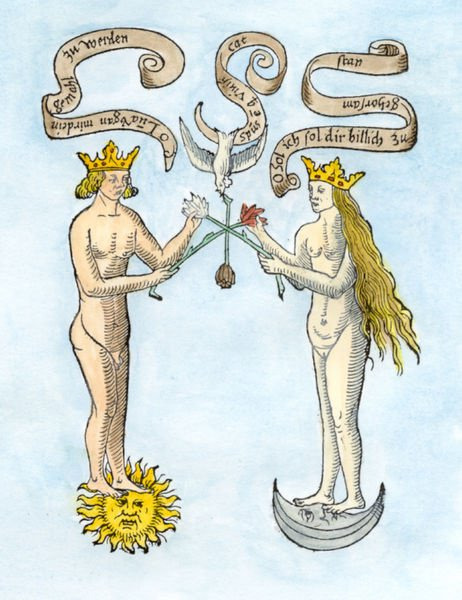
From the Rosarium Philosophorum
Crystal: A synonym for the Philosopher’s Stone at both the white and the red stage. Crystallization is also a word for coagulation, fixing the volatile.
Cupid: Another name for Mercurius in the form of “secret fire” or “burning water.” Cupid’s arrows of passion represent the universal solvent that reduces all substances to prima materia. The essence of love in the arrows refers to the higher nature of the Stone/elixir. Also a symbol of Mercurius as the mediator in the Chemical Wedding, who marries Sol and Luna.
Dawn: Represents the albedo stage, because the light of dawn is pale like moonlight, and it is followed by the blazing risen sun that represents the rubedo stage.
Decoction: Heating an ore or mineral, also extraction of the liquid essence of a substance by boiling.
Death: The nigredo stage of the Opus, during which soul is separated from the body and the body putrefies or is dissolved. Represents unenlightened consciousness and the rejection of the mundane self, being freed from the confines of one’s earthly body. An alchemist must metaphorically cast off the mortal coil without physically dying. Death is like a gate on a circlular path. You have to go through the gate, or you will never be able to continue around the circle. You’ll just stay stuck in place. To become immortal and continue forever around the circle, you must die, and cannot fear death.

From the Twelve Keys of Basil Valentine
Deer: Represents the soul. The “fleeing hart” represents Mercurius, specifically the flightiness of Mercurius, and also his role as the messenger and mediator between body and spirit. He is both a faithful servant (i.e. “servus/cervus,” deer) and an elusive and deceptive enigma that must be captured by the alchemist. According to Paracelsus, its antlers heal wounds.
Den: A word for the vessel during the nigredo — the serpent’s or dragon’s den, or spirits’ den.
Devil: A symbol of sulfur.
Devour: If animals or people devour each other, it usually represents an opposing state overcoming the other — such as the volatile (a winged creature) overcoming the fixed (the other animal), Saturn devouring the divine (mercurial) child, etc. Devouring is often a representation of solve, one substance or state being consumed by the other, but it’s also coagula in that it unites the fixed and volatile. The animals can also represent the earthly nature of man being destroyed. Something must die for a newer and purer thing to exist. Sometimes devouring is a metaphor for sex, a particularly violent rendition of the chemical wedding. It’s violent to symbolize the intense opposition of the substances.
Dew/Rain: The healing aspect of mercurial water. The blackened, putrefied matter of the Stone is washed in the dew and turns white (ablution). The dew falls like rain from the celestial spheres and reanimates the dead matter. “It ascends from the earth to the heaven and again it descends to the earth.” Precedes the second chemical wedding, when the purified soul is reunited with the body.
Diana: The matter of the Stone in the white stage, the White Tincture, the female principle, argent vive.
Dissolution: Stage Two. Dissolving the powder in (mercurial) water made from the condensed vapours from calcination. This represents self-awareness, dissolving your prejudices and old patterns, understanding the psychological roots of your behaviors. The first stage of Shadow work. Returning to the Abyss, the primordial waters, again and again and again. Purification by water.
Distillation and Sublimation: Stage Five. The process in which the volatile spirit is extracted from the impure body. It vaporizes (sublimates) and then condenses. Metaphysically, it’s katabasis, the necessary descent of the soul into base matter – “the way down is the way up.” You can’t ascend without having descended first. What Goes Down Must Come Up.
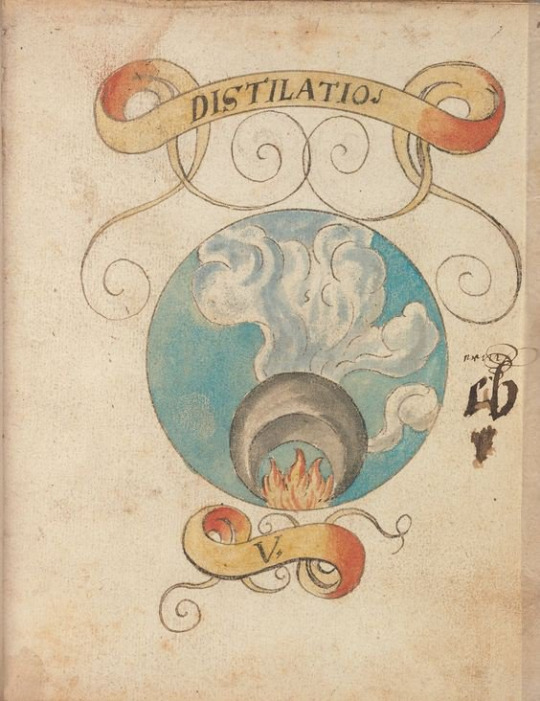
From The Crowning of Nature
Dog: A male dog represents sulfur while a female dog represents quicksilver. Two dogs having sex represents the most “primitive” form of the Chemical Wedding (which can also be represented by copulating dragons or lions).
Dove: A symbol of the albedo, the white stage, and purity following corruption. Also a symbol of Mercurius as the mediating force in the Chemical Wedding, uniting the forces of sulfur and quicksilver.
Dragon: Mercurius in his chthonic aspect as prima materia. Two dragons, one winged and one wingless, represent quicksilver and sulfur (respectively). They copulate, then kill and devour each other, then are entwined together around the caduceus in unity. Mercurial water is called “dragon’s blood” in its aspect as a universal solvent. It is the dragon that guards its horde of gold in the Abyss of a cave .The dragon represents the “base” self that the higher self must tame, represented by the dragon being slain by a solar hero (Apollo, Marduk, Siegfried, Beowulf, Harry Potter, etc.).
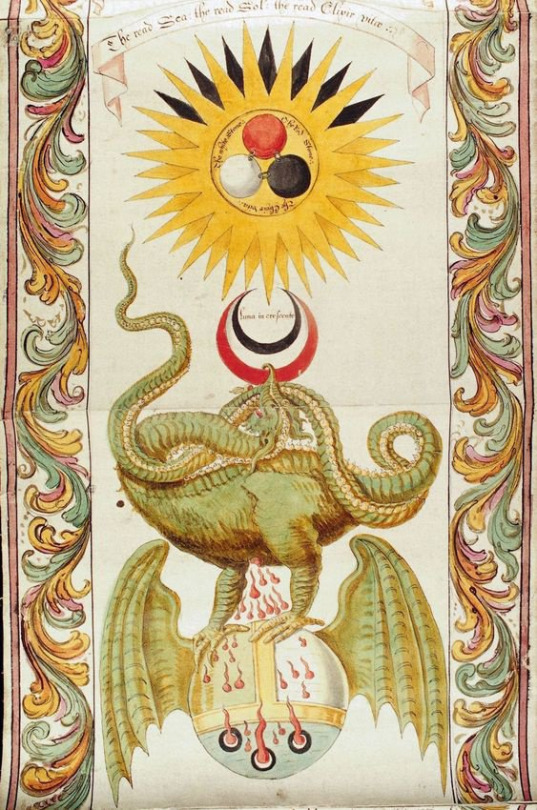
From The Ripley Scroll
Dregs: The impurities of the Stone that are left behind during dissolution and sublimation, that sink to the bottom of the vessel.
Dust: The purified body of the Stone during the albedo stage, which collects on the sides of the vessel through sublimation. (Also called ash, snow, or white foliated earth.)
Dye: A metaphor for the white stone turning red or purple. The Stone is “washed” in the Red Tincture, like dying cloth. Tyrian purple in particular is a metaphor for eternal spiritual perfection, because it is a permanent dye and rare. The Stone being stained with blood is the same metaphor.
Eagle: The White Tincture, another symbol of Mercurius during the albedo stage after sublimation. When paired with the lion, the lion represents the fixed state and the eagle represents the volatile state — if the eagle devours the lion, it’s a symbol of solve. The lion is devoured by the eagle to make it spiritual, and the eagle’s wings are clipped to make it corporeal.
Earth: Corporeality, the physical world, stagnation, fixation. The dense body of the Stone, represented by Saturn. (We live in the physical world, so the other elements are not their “true” selves, but perceived as correspondences that symbolize their true selves “through” the Earth element. It allows the other elements to “rest.”) Its properties are cold and dry.
East and West: Respectively, sulfur and quicksilver. Sulfur is dry and hot, quicksilver is cold and moist.
Eclipse: The solar eclipse represents the nigredo, when the impure matter of the Stone putrefies, death preceding rebirth. Described as a “black gate” that sulfur and quicksilver must pass through. The moon “dissolves” the sun. Symbolized by the Green Lion devouring the sun. (Also called sol niger. For the lunar eclipse, see sun and shadow)
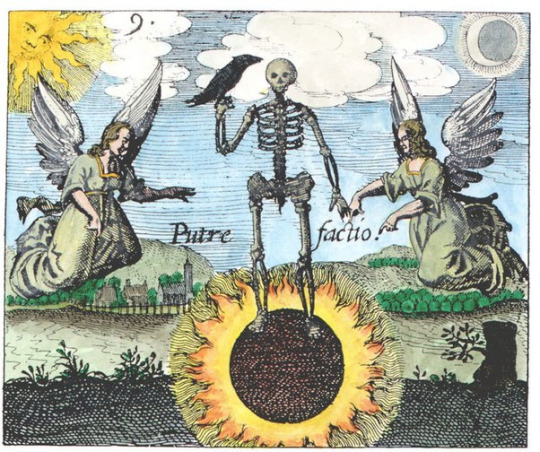
From Philosophia Reformata, by Johann Daniel Mylius.
Egg: The vessel. Hatching of an egg is a metaphor for the creation of the Stone. The fire of the athanor is like a mother bird incubating her eggs.
Elements: Earth, Air, Fire, and Water. The Philosopher’s Stone must be made of all four elements in the right amounts to produce the perfect fifth element, Quintessence. Earth is cold and dry, Water is cold and wet, Air is hot and wet, and Fire is hot and dry. Earth can be mixed with water because they are both cold, Water can mix with Air because they are both wet, and then Air can mix with Fire because they are both hot.
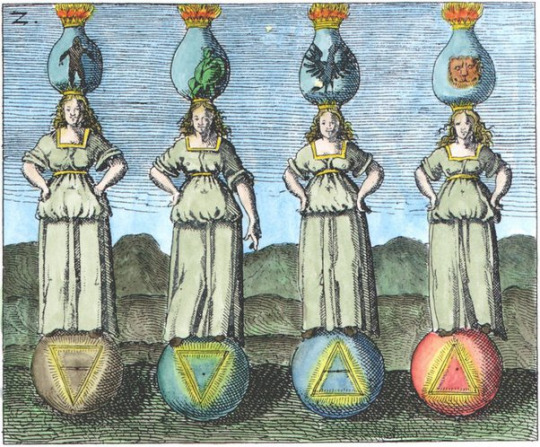
From the Viridarium chymicum
Elysium: A name for the white stage, a pure and beautiful garden of symbolic plants that immediately follows death.
Eyes: The rainbow “peacock’s tail” stage between nigredo and albedo.
Exaltation: Stage Eight. The material turns red, with all of its components fusing into one whole and becoming stable in the most intense heat of the furnace. The Stone has appeared. Once the ecstasy peaks, the body, soul, and spirit permanently fuse. Also called Fixation.
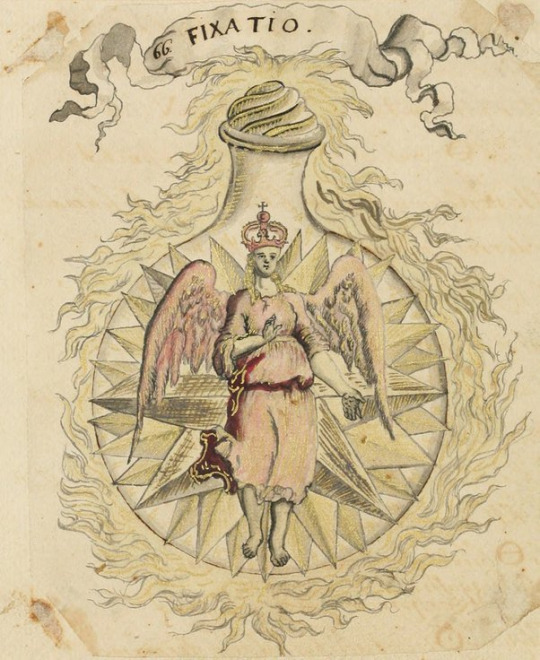
From The Crowning of Nature
Feathers: A bird eating its feathers symbolizes the dissolution that occurs after the chemical wedding (also symbolized by a child playing in a bath), Also a symbol of the “peacock’s tail” stage.
Fermentation: Stage Six. Permanently infusing life force into dead matter. The spiritual and base aspects of the self are united, and one is freed from superficial or “worldly” desires and concerns. The enzymes that cause fermentation represent the soul “quickening” the body. The material turns yellow and becomes gold. Add some gold to it to facilitate this change, like putting seeds into the earth. “Intoxicated surrender to one’s true inner self” (Richard Cavendish), seething emotions and ecstasy.
Field: Potential, the potential to “cultivate” the philosopher’s stone, in which the “seed” of the soul is sewn to be transformed into its realized potential, the flower. This happens through the course of the seasons—winter (black), spring (clear/white), summer (red), and autumn (gold).
Fire: The element, the essence of divine love, which causes transmutation. It is hot and dry, and inherently spiritual, a sort of microcosm of the Sun. The “secret fire” is purifying and transformative. The heat and intensity of the fire in the athanor increases as the Work progresses through the stages. Also represents the Divine Masculine. Symbolized by the Sun and Gold. In its impure form, as sulfur, fire is also individualization and the ego, which becomes consuming and desirous. Often conflated with mercurial water/argent vive, which “burns” and dissolves things.
Flood: Dissolution and putrefaction, with Noah’s Arc or a similar boat symbolizing the Vessel. The waters of the deluge drown and destroy everything, until they suddenly transform into the waters of life. The rainbow that follows the Flood is the Peacock’s Tail.
Flowers: Fully realized potential, resurrection, exaltation, rising from the depths of the Earth. (The stem is virile, the flower itself is elemental.) The rose in particular has mostly the same symbolism as the cross. Also a word for the powdery version of the body that is a result of sublimation. Also a symbol of the Philosopher’s Stone, the perfect substance. Flowers bloom as a result of Earth, Water (rain), and Fire (sunlight). White roses or lilies symbolize the albedo, golden flowers symbolize citrinitas, and red roses symbolize the rubedo.
Fountain: Purifying mercurial water, that generates all other metals. Same symbolism as the bath.
Fruit: Raw gold before it is transmuted into the Philosopher’s Stone. If the fruit putrefies in the ground, then its seeds will sprout into new trees. The Philosophical Tree bears gold and silver fruit representing the Sun and Moon. Bearing the fruit is a symbol of increasing spiritual awareness, and eating the fruit represents gaining that spiritual knowledge. Sometimes the golden fruit is specifically the Apples of the Hesperides, guarded by the dragon.
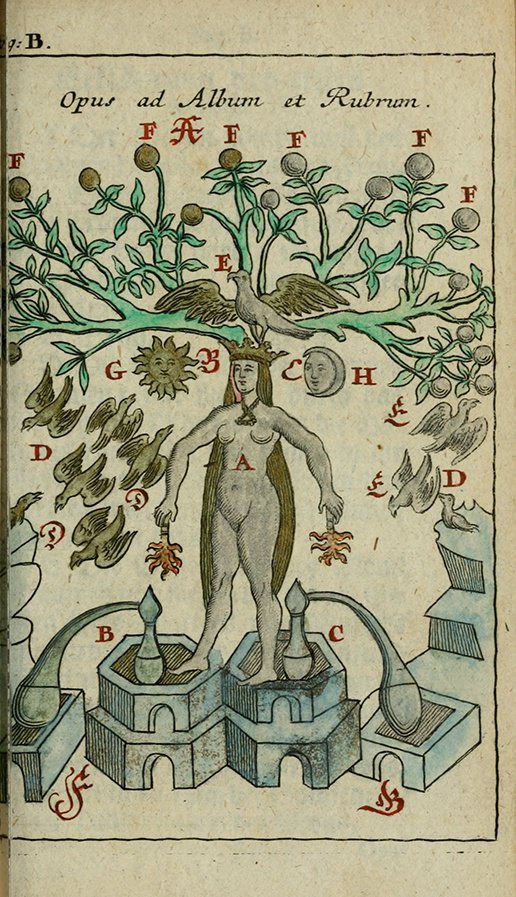
From Compendium Alchemyst by Johann Michael Faust
Furnace: The athanor in which the alembic or Vessel is heated. It contains “philosophical fire” (the soul), which purifies the matter in the Vessel. It causes suffering but also removes impurities. You have to suffer in the fire to be cleansed, and rise from it like the phoenix.
Garden: The Vessel, in which the philosophical tree grows. Sometimes also a rose garden, with red and white roses. The blooming of the roses represents the attainment of spiritual wisdom.
Glass: The Vessel. When the alchemical couple (Sol and Luna, or sulfur and quicksilver) die and enter the putrefaction stage, they are “shut in a glass.” The vessel can be symbolized as a glass house, glass prison, or glass coffin. Making glass is also a metaphor for the fixation process, because the volatile liquid crystallizes into hard glass.
Glue: The medium by which Sol and Luna are joined together during conjunction, that which officiates their Chemical Wedding. A form of Mercurius, the mediating soul that unites the body and spirit. Usually symbolized as a dove. Also symbolized as gum or resin from the philosophical tree.

From the Rosarium Philosophorum
Gold: A pure, condensed form of the solar force and the Divine Masculine, and the ultimate goal of alchemy, representing spiritual perfection. It is the microcosmic Sun. It can “endure the trials of fire” (i.e. it has a low boiling point). All metals were thought to contain the potential to “ripen” into it, under the right conditions. Figuratively, this means that all people have the potential to become pure spiritual beings. The golden soul is one that has died and been resurrected as a purer thing, whose spirit has become fixed, and who has therefore attained a kind of earthly divinity.
Golden Fleece: A symbol of the Philosopher’s Stone. The quest for the golden fleece represents the alchemists’ quest for the Stone. Also a term for a supposed book made of sheep vellum that details all the secrets of the Great Work.
Grain: A term for the “seed” of metals, which grows into Sol and Luna (gold and silver). The Stone is also compared to grain or corn that has to “die” before it can bear fruit. “Purple grain” is the Red Tincture.
Grapes: Prima materia, the raw material of the Stone. Grape juice or wine represents the mercurial water of dissolution. A grapevine can also represent the philosophical tree, with the red fruit being the Philosopher’s Stone.
Grave: The Vessel during the nigredo stage, when the matter of the stone dies and putrefies. The dead bodies of the alchemical lovers are shown in a tomb or coffin.
Green: The color of the maturing Stone, after it has been born. It is the color of fertility and growth, so it represents the Stone’s capability to multiply itself and cause the “seeds” of metals to “mature” into gold and silver. It also represents the generation of the Stone after the Chemical Wedding.
Green Lion: Raw antimony ore (stibnite), “unclean” or “impure” material of the Philosopher’s Stone. Prima materia at the earliest stage of the Opus. The volatile mercury (spirit) is extracted from it. Associated with Latona (Leto, from whom Apollo and Diana as the Sun and Moon are born). It is green because the vital essence of fecundity comes from it, but also because it is an early and “immature” form of the Stone (like unripe fruit). Represents Mercurius in its form as a solvent: the lion eats the Sun, causing the nigredo and dissolution. After it is dissolved into prima materia, the “seed” can grow. The Green Lion also represents Mercurius as the “glue” that marries the Sun and Moon.
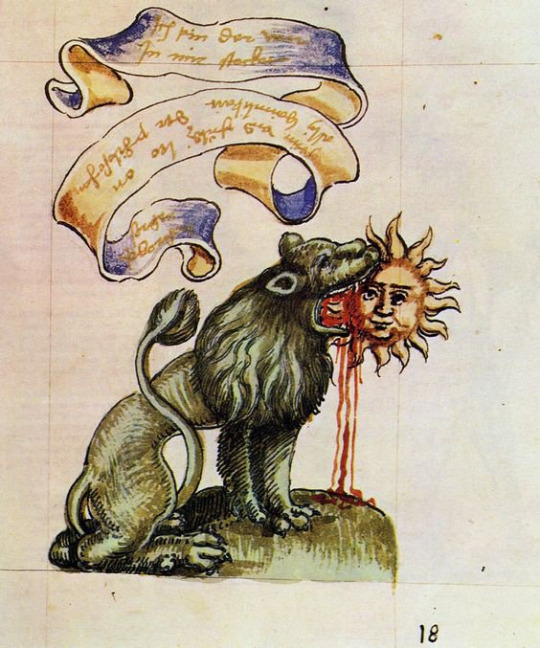
From the Rosarium Philosophorum
Griffin: A symbol of argent vive/quicksilver, the female principle. The feminine equivalent of the red lion. They fight each other, symbolizing the Chemical Wedding at its most early stage. (Combines the volatile eagle with the earthly lion.)
Halcyon (Kingfisher): A symbol for philosophical mercury, which is supposed to be sky blue. It is a universal solvent, able to destroy and then revitalize anything.
Harvest: The completion of the Opus and attainment of the Stone. The Great Work is often compared to the cultivation of a tree or a flower.
Head: The vessel or alembic, also symbolized by a helm. The vessel itself is a metaphor for the human body, and the real transmutation takes place in one’s head (i.e. mind). A person with black feet, a white body, and a red head is a symbol of the Opus. A severed head is a symbol of nigredo and dissolution, the separation of the soul from the body.
Heaven: The subtle matter of the Stone, the volatile vapor at the top of the alembic (as opposed to the “white foliated earth” at the bottom). “It ascends from the earth to the heaven and again it descends to the earth.” Quintessence is also called “heaven” because it is a perfect substance and it is bright blue.
Hell: The black matter of the Stone during the putrefaction stage, which is destroyed by fire (or “secret fire,” mercurial water). This stage is the descent into the Underworld or Tartarus.
Hermes’ Seal: The seal made of a special clay that keeps the alchemical vessel closed and airtight. The sealed vessel functions as an isolated cave or sanctuary in which one can seek enlightenment.
Hermes’ Tree: The philosophical tree, which must be tended by the alchemist and nourished with mercurial waters and then harvested. Another symbol for the Philosopher’s Stone.
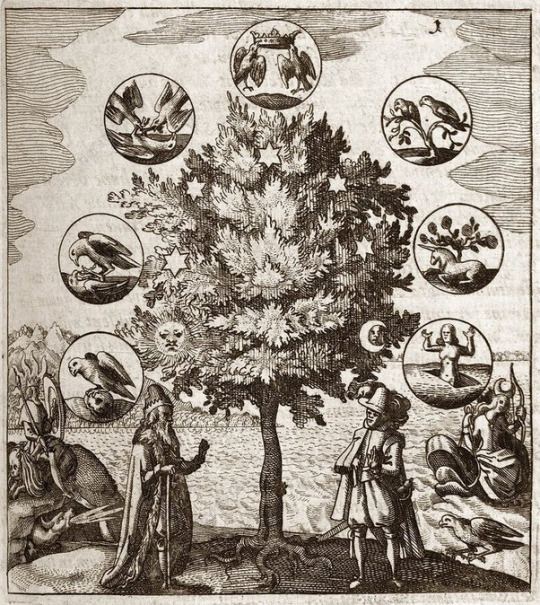
From Philosophia Reformata, by Johann Daniel Mylius
Hermes Trismegistus: The legendary inventor of alchemy, said to be an incarnation of both Hermes and Thoth. Called “thrice-great” because he was a king, a mage, and a priest. Said to have written the Emerald Tablet and the Corpus Hermeticum.
Hesperides: The garden in which the philosophical tree grows. The Golden Apples of the Hesperides are another symbol for the Philosopher’s Stone.
Homunculus: An artificial human created in an alembic. Also a symbol of the Philosopher’s Stone in its infantile state. Represents the birth of the divine child inside one’s own soul. The Stone is figuratively a “baby” that must be gestated and raised, both in the alembic and spiritually in one’s soul. (i.e. You are reproducing God’s creation of yourself in a microcosm.)
Honey: Another name of mercurial water, in its aspect as a healing agent instead of a “burning” solvent. A symbol of the Elixir of Life and the panacea, because it is a sweet gold liquid.
House: The Vessel. It’s made of glass, shaped like the squared circle, and “sweats” (condensation).
Inversion: Alchemy constantly involves reversal — flipping between states of matter, releasing the soul from the body and then bringing it back down into the body, dissolving a substance down into prima materia and then reforming it. Descend before you can ascend, go backwards to go forwards. As above, so below. This is why Mercurius is dual-natured.
Inverted tree: The upside-down philosophical tree has its roots in heaven, which means that its nourishment comes from the Divine (Mercurius), and it “returns” to the earth.
Iron: Represents Mars, action, virility, and violence. If one can separate the virile warrior component from its corporeality, it can become Gold. Iron is “fixed” Sulfur. When treated by Water (female principle) and Fire (male principle), it becomes “purer” Steel. The production of steel is therefore a microcosm of the Great Work.
Jackdaw: Being a corvid, it’s another symbol for the nigredo stage, death and passage through hell.
Jupiter: Represents the metal tin, and the color gray. Tin is “imperfect” but takes only a little bit of work to become perfect (i.e. turn to gold). Also represents fire as in actual fire (not “secret” or “philosophical” fire). Zeus bringing Ganymede to Olympus in the form of an eagle represents sublimation. He also turns into a shower of gold to visit Danae — Jupiter easily turns to gold.
King: The matter of the Stone, as well as the hot and dry male principle — sulfur in its impure state, gold in its pure state. He is the Sun, and must be “married” to his female counterpart, who represents mercury and the Moon. He represents the conscience and the Divine Masculine. The King is both the philosophical child and its father (implied to be the same being). He dies and then is resurrected. His drowning in the ocean or a bath is a symbol of dissolution, followed by a gentler washing of his body, then he is married to the Queen. The resulting child is the Philosopher’s Stone, who also grows up to become a King.
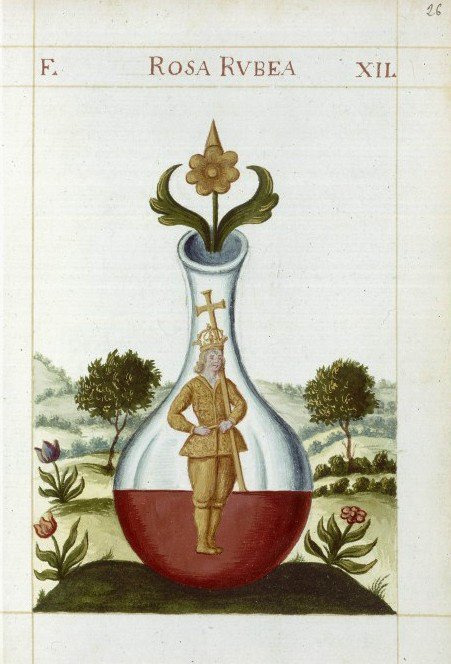
From Pretiosissimum Donum Dei
Labyrinth: The dangerous and confusing process of the Great Work. The labyrinth is full of illusions, and only with divine inspiration can one make one’s way through.
Latona: An imperfect or impure version of the Philosopher’s Stone, represented by bronze or brass (or copper). Similar in nature to the Green Lion. The blackened body of the stone preceding the albedo stage, that must be washed to remove its impurities. She is both metallic ore and the bowels of the earth from which it comes. (The name “Latona” comes from Leto, the mother of Apollo and Artemis, i.e. the mother of gold and silver.)
Laundry: Ablution, washing the Stone to cleanse it of its impurities during the white stage. The stained sheets represent the impure matter, which must be washed so that they will turn pure white. (When the sheets are later dyed red or purple, it represents the rubedo.)
Lead: Prima materia, the raw material that is made into the Philosopher’s Stone and also transmuted by it. The former is “philosophical lead,” the matter of the Stone during the nigredo stage. Represented by Saturn, who can be interpreted as an “aged” Mercurius. White lead is “purified” lead in the albedo stage. Symbolizes the chaotic and melancholic state of the soul after having been separated from itself. (also called Adrop)
Leprosy: The “imperfection” of metals, i.e. lead, copper, tin, and iron are just “diseased” gold and silver. They need “medicine” in the form of the panacea or Philosopher’s Stone. (also called rust)
Lily: The White Tincture and White Stone, the matter of the Stone during the albedo stage. Symbol of purity, perfection, the Moon, and the female principle. Therefore it also represents silver, quicksilver, and Luna/the Queen. It’s paired with a red rose, which represents the male principle. (A white rose symbolizes the same things.)
Lotus: A circular flower with a vertical stalk on horizontal water, therefore the same meaning as the ankh symbol—life, rebirth, resurrection, eternity.
Lute: A kind of clay used to seal the vessel/alembic. It’s made of various things — glue, flower, herbs, honey, egg whites, wax, resin, vitriol…
Magistery/Magisterium: A name for the Great Work. Means literally, “quality of mastery.”
Magnesia: Refers to several substances, all symbols for Terra Alba, “white foliated earth.” Also a name for Mercurius in the form of Quintessence.
Marble: A symbol of the White Stone, which is acquired during the albedo state.
Mars: Represents the metal iron, and the color red. Follows Venus in the Opus, and is associated with the “peacock’s tail” stage. He symbolizes the violent, impure form of the Divine Masculine, symbolized by the Red Lion.
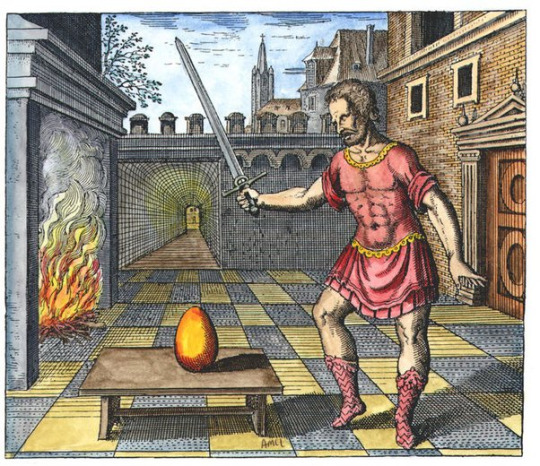
From Atalanta Fugiens
Medicine: The Philosopher’s Stone in the form of a panacea. It can supposedly cure any disease, and also transmute “diseased” metals (copper, iron, tin, lead) into gold and silver. The idea of a panacea is more metaphorical, curing “diseases” of the soul and transforming human beings into enlightened and divine versions of themselves. In short, it raises the vibration of anything it comes in contact with.
Melancholia: The state of mind that accompanies the suffering of the nigredo stage. It is the initial terror and sadness that you experience upon confronting your Shadow. You end up in the “nox profunda,” the deep night or dark night of the soul, a dark pit of the Underworld which it feels like you will never escape.
Menstruum: Mercurial water, the universal solvent. Called the “blood of the green lion.”
Mercurial water: The universal solvent, which dissolves metals and other matter into the prima materia. Symbolized by a lion or a serpent, and also by water (floods, dew, fountains, rain, tears, the ocean). It first “burns” and destroys everything to “kill” the old state of being, but then transforms into the water of life, washes and revitalizes it. (also called alkahest)
Mercurius: The ultimate agent of transmutation, the purified prima materia and the divine spirit within matter. Both the Philosopher’s Stone, and the Opus that produces it. Sometimes Mercury is described as “philosophical water,” or as fire, or as air or vapor (spirit, soul). It is prima materia, the source of metals, and also their potential to turn to gold. It is the primordial “mother” of the Philosopher’s Stone and also the child, the Stone itself. It is self-begotten, self-generative, self-destroying (i.e. the ouroboros). It is the universal solvent of death, and the animating force of life. Hermes is dual-natured and a synthesis of all opposites. He is both light and dark (i.e. celestial and chthonic) and is not tainted or corrupted by his engagement with darkness. He dissolves and coagulates, creates and destroys, kills and revives. He is an elusive trickster, but also a helpful ally. Alchemical Mercury is also a hermaphrodite, both male and female. Mercury is the spirit that unites body and soul, and weds the Red King and White Queen. Since Hermes is the messenger god who transfers information between the human and the divine, and brings the soul between life and death, he is also a mediator between the mundane self and the Higher Self. Mercurius is also a summary of the entire alchemical process. “Binding Hermes” means making his volatile nature, fixed. First he is the dragon or serpent, then the green lion, then the white eagle. Finally, Hermes’ association with commerce relates to the alchemical production of gold. (Also called Azoth, aqua divina, aqua permanens, aqua regia, aqua ardens, aqua vitae) (Note: Mercurius represents the Stone, not actual mercury. For actual mercury, see quicksilver.)
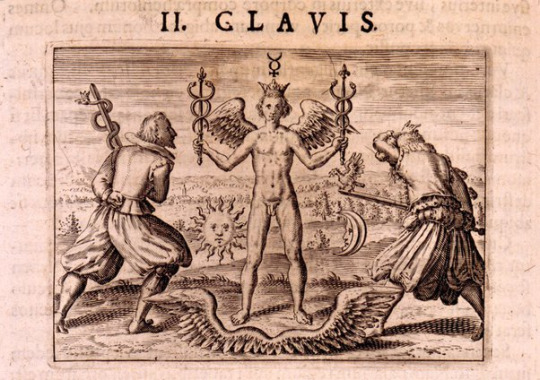
From the Twelve Keys of Basil Valentine
Metamorphosis: A word for transmutation, changing states of matter or states of being. Also, Ovid’s Metamorphoses were referred to as analogies for the Opus by alchemists.
Milk: The pure and spiritual version of mercurial water, extracted from the green lion ore. The White Tincture, which can transmute metal into silver. It nourishes the baby Philosopher’s Stone during the cibation stage.
Mirror: “Divine Spirit,” observing the self, becoming the most divine version of oneself through self-observation and Shadow work.
Moon: Silver and quicksilver/argent vive (actual mercury), the female principle. Also the White Tincture and White Stone in the albedo stage. Luna is married to Sol, the King. Her properties are cold, moist, and receptive to his hot, dry, and active. She is the Divine Feminine, and represents, the imagination, dreams, emotions, intuition, the subconscious, the changeable and volatile, the energetic, the soul. The subconscious is “cleansed” during the white stage. Cold moonlight represents the half-enlightened conscience of the albedo stage. Associated with solve, dissolution, making the mundane spiritual.
Mountains: A symbol for the source of prima materia. To obtain it, the alchemist must climb a mountain and extract the juice of a magic herb that grows on it. Sometimes there’s two mountains, one for the masculine “seed” and one for the feminine one. Going into the mountains can also be a metaphor for isolating oneself to gain spiritual awareness.
Multiplication: Stage Nine. Another sacred marriage/copulation between the Red King and the White Queen, so the Stone can become “fertile.” The Opus repeats itself again and again in rapid succession, with the Stone constantly dissolving and coagulating to create more of itself.
Nest: The Vessel, as a container for the “egg” or “chick” of the Bird of Hermes.
Night: The nigredo, the first stage of the Opus. It’s the Dark Night of the Soul in which the body dies and putrefies, and then is dissolved. The soul experiences a descent into the Underworld.
Oak: The philosophical tree. Also the vessel or athanor, when hollow.
Orphan: The Philosopher’s Stone, because its “parents” (the King and Queen. Sol and Luna) must die so it can be born. The alchemist becomes its foster parent and raises it in their place.
“Our” [substance]: Alchemists use the word “our” to refer to spiritual/metaphysical symbols represented by substances. So, “our mercury” isn’t Hg, it’s the feminine principle of nature. “Our sulfur” is the masculine principle of nature. “Our gold” is the perfect state of being, and not actual gold, Au. “Our [symbol]” refers to the metaphorical thing the symbol represents, not the symbol itself. It was never about making actual gold. If you think it is, you’re missing the point.
Ouroboros: The universe and the Great Work. The Ouroboros is and encircles all things, and thus represents the Principal of Mentalism. It is the circle of life — life returns to that which generated it, and supports other life. It creates itself, and also destroys itself (since it bites its own tail), and therefore is also primordial chaos and prima materia. All things come from it and return to it, and it continues in an eternal cycle. It represents the cyclical nature of the Opus, and also the eternal process of solve et coagula – killing itself, resurrecting itself.
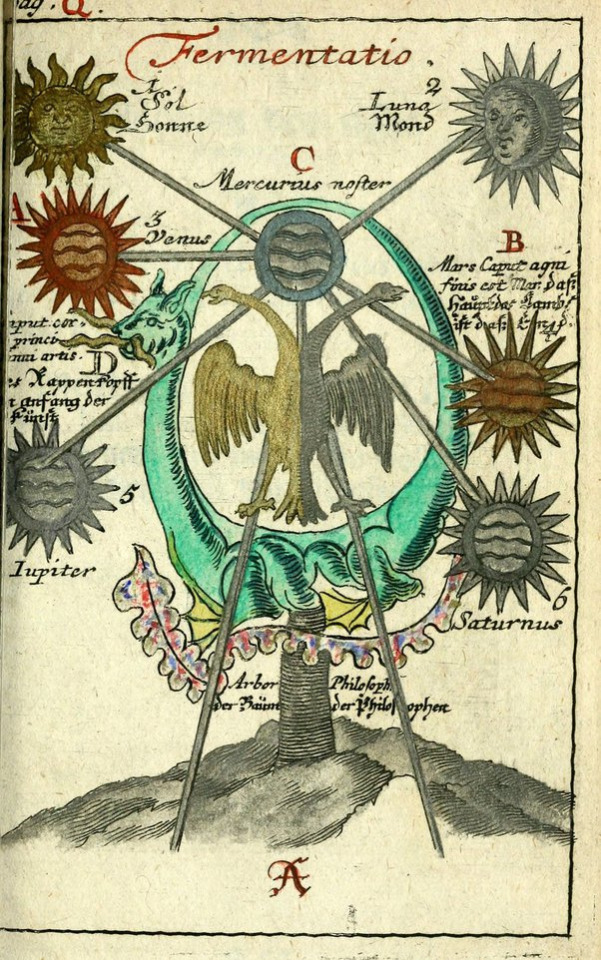
From Compendium Alchemyst
Paste: The whitened matter of the Stone. During the fermentation stage, another chemical wedding happens between the Stone’s purified soul and this white purified body, which is compared to making bread. The paste is bread dough.
Peace: The state when the opposing forces of the Opus (male and female, sulfur and mercury, fixed and volatile, body and soul, etc.) stop fighting with each other and are united in the chemical wedding. This is why a dove officiates the wedding. Signified by the “peacock’s tail” stage.
Peacock’s Tail: The stage between nigredo and albedo, when the stone is washed with mercurial water during ablution. As the blackness is washed away, it is replaced by the iridescent colors of the rainbow. Instead of white splitting into many colors as in a prism, the many colors coagulate into white. Eating the peacock’s flesh integrates the rainbow colors into the single white color, a state of purity and wholeness.
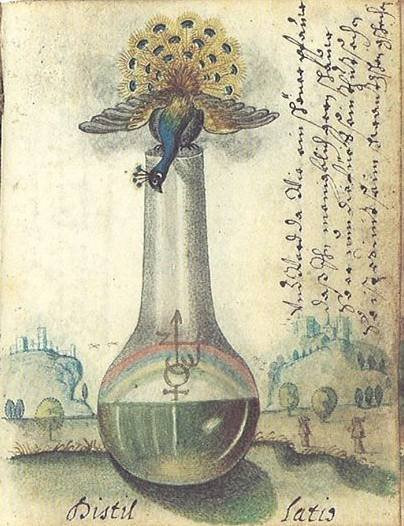
From the Ulrich Ruosch Manuscript
Pearl: A symbol of the ablution stage, because the drops of condensation that result from distillation look like pearls. Also a symbol of the White Stone.
Pelican: A symbol of the cibation and multiplication stage. The pelican bites her own chest to feed her hatchlings with her blood, like the Bird of Hermes feeding the baby Stone with the Red Tincture. (Pelicans don’t actually do this, but were believed to, and were considered symbols of Christ for their sacrifice of their own blood for their young.) Also a particular type of vessel.
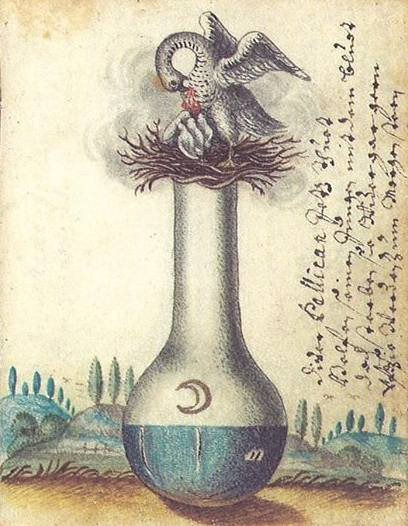
From the Ulrich Ruosch Manuscript
Philosopher: An alchemist. This alone is an indication that alchemy isn’t about science, but about attaining spiritual wisdom. Hence why alchemical substances or symbols are described as “philosophical” – it’s not the literal, physical thing that matters, but the metaphorical or spiritual thing. Alchemy really happens in the mind, not in the laboratory. The alchemists sought to discover how the world works on both a physical level and a spiritual level, simultaneously.
Philosopher’s Stone: The ultimate goal of alchemy, substance that can supposedly perfect all imperfections (which I interpret to mean, it raises the vibration of anything it comes in contact with). It is the substance of divine love and creative power, a crystallization of the essence of life. It can supposedly turn lead into gold, heal all illnesses, and do various other miraculous things. It is created by reproducing God’s creation of the world in the microcosm of the alembic. It is supposed to be a perfect balance of all four elements, and is born from the divine union of the archetypal male and female forces of the universe. It is supposedly created by reproducing God’s creation of the world in the microcosm of the vessel, beginning with primordial first matter (prima materia) and shaping it into sulfur and mercury, which then “marry” and combine to produce the Stone. Honestly, seeking the Philosopher’s Stone is like going on a long Epic Quest for some magical unattainable object (like the Holy Grail or El Dorado), only to discover that It Was Inside Of You All Along, but the journey itself facilitated your character development to make you a better version of yourself. The point was always the journey; the Philosopher’s Stone is a natural result of having undertaken the Opus at all.
Philosophical Child: The newborn Philosopher’s Stone, the result of the Chemical Wedding. The final part of the Opus is compared to raising a child, who is fed and nourished by the alchemist. He grows up into a king and a magician who has power to “vanquish every subtle thing and penetrate every solid thing,” cure all disease, transmute all metals.
Philosophical Mercury: Prima materia or Mercurius. Not the same as “vulgar mercury” or quicksilver (Hg).
Philosophical Tree: Represents the Philosopher’s Stone, the process of the Opus, and also the “expansion of consciousness” that results from it. The process of making the Stone is compared to the cultivation of a tree, and the Stone multiplies itself like a tree bearing fruit. The tree grows from a seed, the “seed” of metals within prima materia, is nourished by rain, and it finally bears gold and silver fruit that represent the Sun and Moon (as well as “perfect” metal). This is all a metaphor for the spiritual growth of the soul towards its ultimate divine form. Sometimes the tree is instead a flower (like the red roses and white lilies, representing the Red and White Tinctures), or a magic herb. Sometimes there are two trees, a gold solar tree and a silver lunar tree. Sometimes it has seven branches to represent the seven planets, making it a symbol for prima materia. Sometimes it grows on an island in a sea of mercurial water, sometimes it grows on a mountain of prima materia, and sometimes it grows in a magical garden of wisdom.
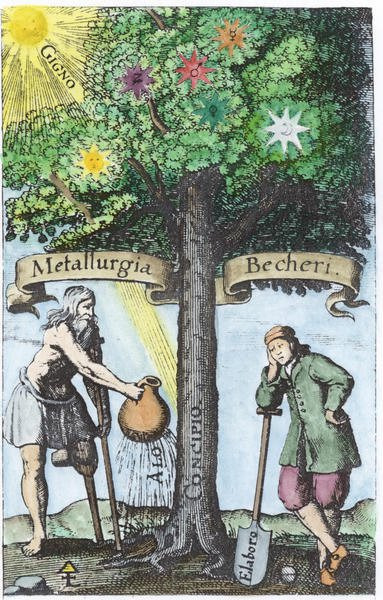
By Johann Joachim Becher
Phoenix: Resurrection, the Philosopher’s Stone in the red stage. Fire in its purest and most spiritual form. Represents rubedo and the multiplication stage, when the Stone/elixir replicates itself. It has been resurrected, and has the power to resurrect itself and others indefinitely.
Poppy: The rubedo, the red color of the Stone or Red Tincture in the final stage.
Pot: The vessel, in this case described as being made of clay and filled with dung to act as a container for the first Chemical Wedding and the nigredo, becoming “pregnant” with the seed of the Stone.
Prima materia: “First matter,” the primordial essence of all things. Alchemists believed that everything was made out of an original substance from which the world was made, and that if you could distill and refine matter (metal, for instance) all the way down into this original substance, you could reshape into whatever you wanted. i.e., reduce lead down to prima materia and then reform it as gold by putting a “seed” of gold into it. Hence “solve et coagula,” dissolve and reform. Symbolically, prima materia represents the soul in its original state. You have to be able to break down the person you think you are, until you are left with nothing but the true core of your being. In Jungian symbolism, it is also the subconscious mind, a dark and scary place that is also the source of inspiration and growth. Prima materia is compared to dirt or dung by alchemists, because it is supposed to something normal and mundane that is found everywhere, and dismissed as worthless by the uninitiated. There are so many symbols related to it, especially water, snakes, earth, seeds, blood, Saturn, chaos, and lead.
Prison: The vessel during the putrefaction stage. The alchemical lovers, Sol and Luna, are imprisoned in it and left to die while their souls rise to the top of the vessel.
Projection: Stage Ten. Using the Stone to transmute other metals, completing the cycle. The Stone raises the vibrations of everything it comes into contact with.
Proteus: The shapeshifting sea god in Greek mythology, a symbol of Mercurius in its volatile state, which takes on many confusing forms and has to be held down until it is tamed and takes its original shape. The sea that Proteus lives in is pirma materia.
Purple: Sometimes used to describe the Philosopher’s Stone and Tincture in its final rubedo state, instead of red. This is because Tyrian purple is very rare and hard to get, must be extracted from snails, and is only worn by royalty. It is the color of attainment, spirituality, and mastery.
Putrefaction: Stage Four. Subjecting the material to a moist heat and letting it turn black. It is now a dead thing with all of its characteristics stripped from it, prima materia. Vapor (the life-spark) leaves it. Represents spiritual death, melancholy, dejection, suffering. The Dark Night of the Soul. Death of the old self paves the way for a new mode of thinking, initiation.
Queen: The matter of the Stone during the albedo. The cold and moist female principle — mercury (Hg) in its impure state, silver in its pure state. She is the Moon, and must be “married” to her male counterpart, who represents sulfur and the Sun. She is also mercurial water in its role as the replenishing water of life or nourishing milk, the White Tincture. She represents the subconscious, perception and the imagination, “higher” spiritual and moral faculties, and the Divine Feminine.
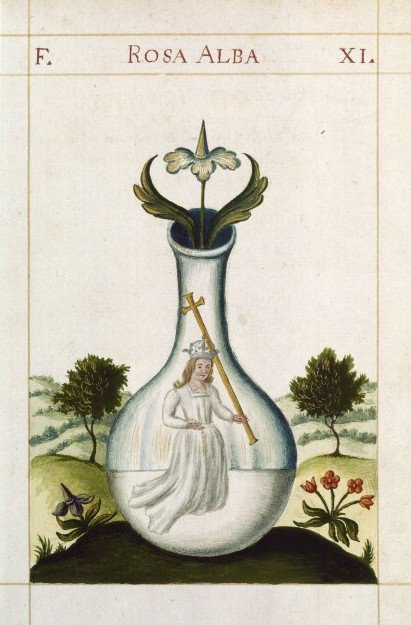
From Pretiosissimum Donum Dei
Quicksilver: Mercury (Hg). The agent of the feminine principle, the “unripe” form of silver. Cold, moist, receptive feminine “seed” of metal that unites with Sulphur to form the Philosopher’s Stone. It is made of Earth and Water. Confusingly, it can also be a symbol for Mercurius in its “slippery” and elusive form. In Paracelsian alchemy, it represents the spirit, the animating force of life. Sometimes also a synonym for prima materia, represented by the dragon or serpent. It has the power to dissolve or vaporize fixed matter. (Also called argent vive.)
Quintessence: (also called Azoth), the fifth element and the result of unifying the other four. It is what the Stone is made of, and in liquid form it is the Elixir of Life. It is purified prima materia, an inherently spiritual substance. Believed to be a panacea. (I interpret it as being able to raise the vibration of anything it comes in contact with.) Symbolized by a crowned maiden, or by Mercurius.
Rainbow: The peacock’s tail stage, which occurs during ablution, when mercurial water falls like rain onto the black dregs. The many colors of the rainbow integrate into white, representing the calmness and receptiveness of the soul.
Raven: Nigredo, when the impure matter of the Stone dissolves and putrefies in the bottom of the flask. It is the initial, death stage of the Opus.

From the Ulrich Ruosch Manuscript
Red: The rubedo, the final stage of alchemy in which the white matter of the Stone turns crimson as the spirit merges with the body. It crystallizes and becomes fixed. Self-actualization and resurrection, the attainment of spiritual enlightenment. Symbolized by blood, red roses, rubies, coral, gold, the Sun, the phoenix, and the King.
Red earth: A name for the base matter of the Philosopher’s Stone, which is dissolved into prima materia and then refined into the Red Stone and Red Elixir.
Red Elixir: The Philosopher’s Stone in liquid form, as a panacea. It can cure all diseases, transmute metals into gold and silver, raise the dead, make old people young again, give strength to living beings, etc. It is “fed” to the baby Stone during the cibation stage, so that the Stone will be multiplied by itself and produce more of itself. (Also called the Red Tincture)
Red Lion (or Dragon): Represents sulfur and the planet Mars. It’s Sol, the masculine principle, in its “impure” state at the start of the Opus: the wild, animalistic, instinctive part of the soul that needs to be “purified” by being defeated. It is “terrestrial man,” the King at his most mundane. It burns everything that it comes into contact with.

From Clavis Artis
Red powder: The Stone in powdered form. It’s cast over or mixed with metal to transmute it, and taken as a medicine.
Red Sea: Another symbol for prima materia and mercurial water, the source of life and death that both dissolves everything and revitalizes it. The crossing of the Red Sea in Exodus is a symbol for how its waters will destroy the uninitiated and show the way forward to the enlightened. It also can be “parted” into four elements.
Refine: Purifying a substance by repeatedly dissolving and coagulating it with water and fire, which slowly removes its defects. This is a metaphor for raising the “vibration” of the soul, from a lower, mundane state to a higher, spiritual state. The soul must endure many trials (fire and water) to reach this state of spiritual purity, until it is pure enough to permanently fuse with the spirit of God and become divine-in-human. Becoming “gold” is to be able to withstand the heat of any “fire” (gold has a very high melting point) and host the Sun within oneself.
Return: The “process of return” is a name for the Great Work, because it is a cyclical process of repeated “solve et coagula.” The matter of the Stone must return to prima materia, the four elements to quintessence, the soul to the perfected state that it was in at the creation of the world, the world itself from the dismal “Iron Age” to the ideal “Golden Age” of the distant past.
River: Another symbol of mercurial water. There are two rivers, one male and one female. The female one dissolves, and the male one coagulates. When the two rivers flow together into a single river, it represents the Chemical Wedding. When the rivers dry up, it represents the crystallization of the Stone in the dry, solar rubedo stage.
Rock: A synonym for the Philosopher’s Stone, for the mountain of prima materia, and also for the vessel in which the Stone is made.
Roots: The four elements are the “roots” of the philosophical tree, from which the Philosopher’s Stone grows.
Rose: The rubedo and the Philosopher’s Stone, the completion of the Opus. A blooming rose represents attaining wisdom and enlightenment. If a red rose is paired with a white lily (or a white rose), it represents the Red Tincture and the King/Sol.
Ruby: The Red Stone. The “celestial” ruby has the power to transmute all metals and make anyone enlightened.
Sable robe: Black garments (mourning clothes) are another symbol of the nigredo, the dark night of the soul.
Sal ammoniac: Ammonium chloride. It’s a symbol of the White Tincture, the matter of the Stone during sublimation, after it has been dissolved. It’s represented by the eagle. It’s also an ingredient in aqua regia, because it produces hydrochloric acid when dissolved.
Salamander: Sulfur, the hot and dry male principle and the masculine “seed” of metals. Although salamanders are amphibious creatures, they were believed to be able to withstand flames, hence why they’re associated with fire. Paracelsus named them as fire elementals, implying that (in this context) salamanders are a type of spirit. Also represents the Philosopher’s Stone and Red Tincture, similarly to the phoenix. The salamander’s blood is the panacea.

From Atalanta Fugiens
Salt: Represents the body and the state of fixation in Paracelsian alchemy, with mercury being the spirit and sulfur the mediating soul. Traditionally, though, it’s a synonym for ashes and white foliated earth, another symbol of matter of the Stone in the white stage.
Sand: Another version of the bath, but the Vessel is placed in heated sand instead of water. Red sand is also a symbol of the raw matter of the Stone.
Sapientia: Divine knowledge and wisdom, which is what the alchemist ultimately hopes to obtain. It is the divine feminine principle, represented by the Queen. Wisdom is personified as a beautiful woman who is an emanation of God. She is the active ingredient in the panacea.
Saturn: Represents the metal lead, and the color black. Also a name for prima materia and for the matter of the stone during the putrefaction stage. In general, Saturn represents discipline, death, and melancholy, so her rules over the harsh nigredo stage. Sometimes he is portrayed as a Grim Reaper or Father Time figure, who destroys all old things to make way for new things.
Sea: Mercurial water, prima materia, the source of all creation. Most creation stories begin with primordial waters of some kind, so of course, the ocean represents this primeval soup of prima materia that contains the potential for all things. (Modern science tells us that life on earth literally did begin in the ocean.) Drowning the King in the sea represents dissolution.
Seed: The spark of life. All metals were thought to have a “seed” within them that could produce the Philosopher’s Stone, when the metal was dissolved into prima materia and the seed extracted from it. The hot and dry male seed is sulfur, and the cold and moist female seed is quicksilver. The seed could theoretically “grow” into gold, under the right conditions and with aid from the Philosopher’s Stone.
Separation: Stage Three. The mixture of ash and “water” separates into its base materials (the four elements, mercury and sulfur, etc.). This represents sorting out the aspects of your mind. It feels like you’re now split in two, Ego and Shadow, warring with yourself. There’s a danger of self-loathing.
Serpent: Prima materia. Mercurius in the form of primordial chaos, dark and destructive. The universal solvent is the serpent’s venom, which can reduce any metal to prima materia. Chthonic or cosmic serpents so often represent primordial creation in mythology — Apophis and Nehebkau in Egypt, Tiamat in Mesopotamia, Shesha in Hinduism, etc. Mercurius also manifests as two serpents that represent the male and female seeds of metals – the female one is winged, and therefore the volatile spirit hidden in the matter of the Stone, while the male one is fixed and does not have wings. They fight each other until Hermes places his wand between them, and they coil around it to form the caduceus. After these two serpents die in the nigredo stage, the primordial serpent becomes the river serpent who cleanses and resurrects them with the water of life. Finally, it becomes the representation of the Philosopher’s Stone.
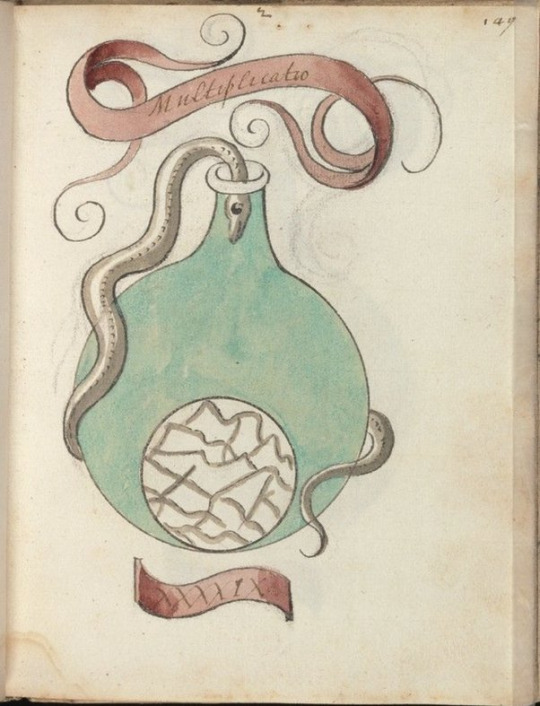
From The Crowning of Nature
Ship: The vessel, during nigredo and the dissolution that follows. If dissolution is symbolized by a flood, then the alchemical vessel is the ship. Same symbolism as a coffin.
Silver: The symbol of the albedo stage, the Whtie Stone, and the White Elixir, as well as the Moon and the Queen. A pure, condensed form of the lunar force and the Divine Feminine.
Snow: The matter of the Stone during the albedo, the same as white foliated earth. The dust that collects on the side of the vessel during sublimation. Throwing snow in Saturn’s face is a symbol of turning the blackened matter of the stone white, as the Work progresses into the albedo stage.
Seven: Creative power, transcendence. Three creative principles (sulfur, mercury, salt) + four elements, nature creating nature. Transitioning to “nonhuman” consciousness.
Soul: The vapor that results from dissolution, because it is volatile and therefore the spiritual part of a living being. The divine or “higher self.” When the matter of the Stone is dissolved into prima materia, the soul is released and floats upward. It unites with the spirit in the Chemical Wedding, during the albedo stage.
Spirit: The spark of life, the spiritual essence of a person or substance, mediating between the dead body and the soul. Symbolized by flying birds in the flask, and represented by mercury (quicksilver) in Paracelsan alchemy
Square and Circle: A symbol of the Philosopher’s Stone. The square represents the four elements, and “squaring the circle” means uniting those four elements into one Quintessence. The four-sided square is the material world, and the eternal circle is the spiritual world. It’s also a symbol of sacred geometry and harmony, the proportionality of the microcosm to the macrocosm.
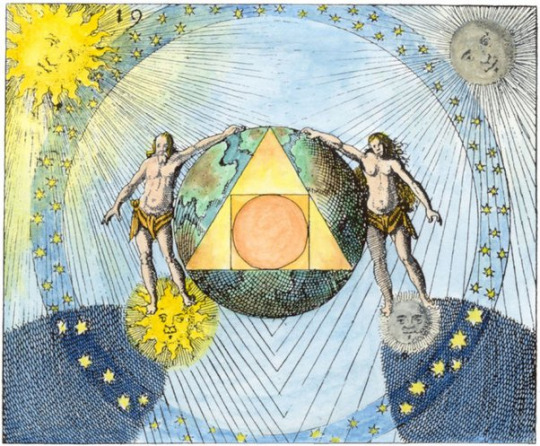
From Philosophia Reformata by Johann Daniel Mylius
Stain: The impurities in the matter of the Stone that have to be filtered out through the continued process of refinement, solve et coagula. Ablution is the stage of washing the stains away, following death and dissolution. Washing away the stains is a metaphor for acknowledging one’s own shortcomings, and working through one’s faults to become a better person,
Star: Another symbol of Mercurius. A six-pointed star represents Mercurius’ ability to unite opposites (the upward- and downward-facing triangles; as above, so below), If it has a sun and moon in the middle, it represents the Chemical Wedding. A six-pointed star also contains the triangular symbols for all four elements. Stars also symbolize the Stone as the perfected human being. The “milk” that the baby Stone is nourished with comes from the stars. (Also a symbol of antimony, because antimony crystallizes in a star pattern when reduced with iron.)
Sulfur: An “impure” (physical) agent of the masculine principle, the “unripe” form of gold, Hot, dry, active masculine “seed” of metals that has to combine with feminine mercury (quicksilver) to form the Philosopher’s Stone. It is made of Air and Fire. It is not literal sulfur, but the mundane mind or consciousness. It is combustive and violent, but it is able to fix the volatile. It is symbolized by a red lion or the Devil. In Paracelsian alchemy, it represents the soul, and is the force of structure, stability, substance, and growth.
Sun: Represents the metal and color gold, and “philosophical gold.” He is the Divine Masculine, represented by gold, or sulfur (in an impure state). Sol is married to Luna, the Queen. His properties are hot, dry, and active to her cold, moist, and receptive. He represents individualization, completion and perfection to the point of centrality, stability, equilibrium, and order. The state of being divine. Also represents the illumination of consciousness, the Red Tincture, and Red Stone during the rubedo, at the completion of the Opus. It represents the state of being the Philosopher’s Stone, the “perfect incarnation.” Its rays have the power to transmute metal and give life. Associated with coagula, congelation, the giving of form and physicality to the subtle or spiritual.
Sun and Shadow: A strange symbol of the projection, the final stage of the Opus. The Sun shines, and casts a shadow, which is a symbol of the Philosopher’s Stone being cast over other metals to turn them to gold. The Shadow is part of what makes the Sun what it is, because wherever there is light, there is shadow. Sometimes the Shadow itself is the Philospher’s Stone, because it is a microcosm of the Sun, which is the macrocosm. It is like a reflection or impression of the Sun. Sometimes the Moon is the Shadow, because it reflects the Sun’s light, so the lunar eclipse is the Chemical Wedding – the integration of conscious and subconscious. During the lunar eclipse, the moon turns red, like the Philosopher’s Stone. The solar eclipse symbolizes the beginning of the Great Work, while the lunar eclipse symbolizes the end, though both could be interpreted as symbols of the Dark Night of the Soul and the integration of the Shadow self.
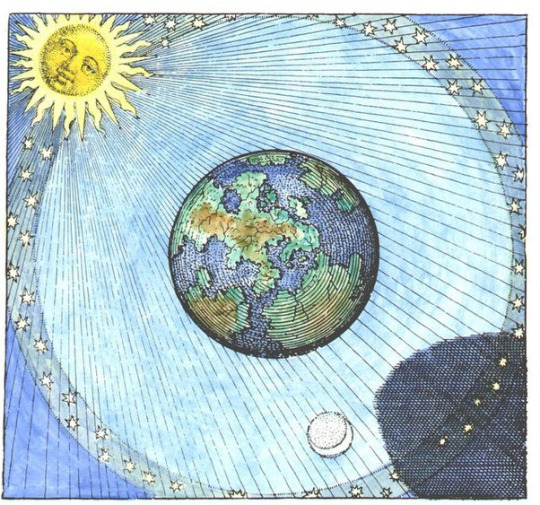
From Atalanta Fugiens
Swan: The albedo, the White Tincture and the White Stone. It swims in the mercurial water, It is feminine and lunar, and able to transmute metals into silver, and represents spiritual purity.
Sweat: The dew or condensation on the side of the vessel during the distillation phase, and is used to wash the dead body of the King during ablution. It’s also the King’s own sweat as he dies, therefore Mercurius as the waters of both life and death.
Sword: Represents “philosophical fire,” the destructive force of Mars and the Red Lion/Dragon. It kills the King (the matter of the Stone), which results in the nigredo stage. (An axe, a knife, Saturn’s scythe, or animal teeth and claws all have the same symbolism)
Tartarus: The dregs or sediment of wine. The Underworld, that which is left behind by the once-living world.
Tears: Mercurial water in the form of the water of life that washes the dead matter of the Stone and cleanses it of impurities. Same symbolism as sweat and dew/rain, the condensation on the sides of the alembic during distillation. In this context, the tears come from grief over the dead King, bird, or lovers.
Temple: Another name for the Vessel, containing all the secrets of alchemy and generation.
Theatre: Alchemical treatises call themselves “theatres,” because they provide a view of the Opus. The Opus itself is compared to a theatrical performance taking place on a stage, and watched by an audience, with all the apparatus being the set and the individual stages being acts and scenes. The theatre is therefore another symbol of the Vessel or alembic.
Tincture: A liquid that is able to tint or color other things. The Stone in liquid form is called a “tincture” because it is able to “color” metals when poured on them to turn them into gold and silver.
Toad: The matter of the Stone during the putrefaction stage, which is black, ugly, and swollen. Also a symbol of prima materia – hardened, earthy primordial matter that’s poisonous but that can be made into the Stone. Means the same thing as the snake or dragon, the crow or raven, and the Green Lion. If paired with a volatile eagle, it represents sublimation.
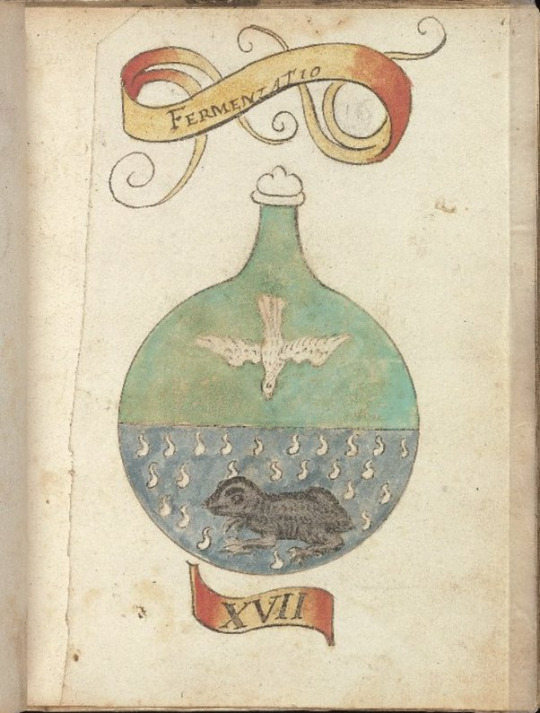
From The Crowning of Nature
Torture: Calcination, reducing a metal to ashes and prima materia during the nigredo stage. This requires being burned in purifying fire. Beheading the king, chopping down a tree, or the bird eating its wings all represent the same thing. This is a symbol of the psychological torment that one must go through during the nigredo, to become self-aware and spiritually pure.
Trees: Prima materia — the force of manifestation, wisdom, the Divine, alternately a creative and destructive force. Yggdrasil provides wisdom to Odin at the cost of his suffering. The Tree of Paradise provides divine knowledge at the cost of sin, etc. Also, “As above, so below,” since the tree’s roots spread beneath it and the branches spread above it. It can also represent the dual nature of mankind, being both divine and mortal, connected to the Astral world and the terrestrial world.
Twins: Sometimes the Red King (sulfur) and White Queen (quicksilver) are interpreted as twins, the two principal forces of nature that are born from prima materia and united with each other. They seem to be opposites, but they’re of the same stock. Sometimes they’re conjoined into a two-headed hermaphrodite.
Unicorn: The masculine aspect of Mercurius, which can penetrate with its horn. Represents the spirit, while the deer represents the soul. The deer and unicorn must both be captured and tamed by the alchemist, so that they will mate with each other, representing the second Chemical Wedding between soul and spirit (during the albedo stage). The unicorn can only be tamed by the Virgin, who represents the feminine aspect of Mercurius.
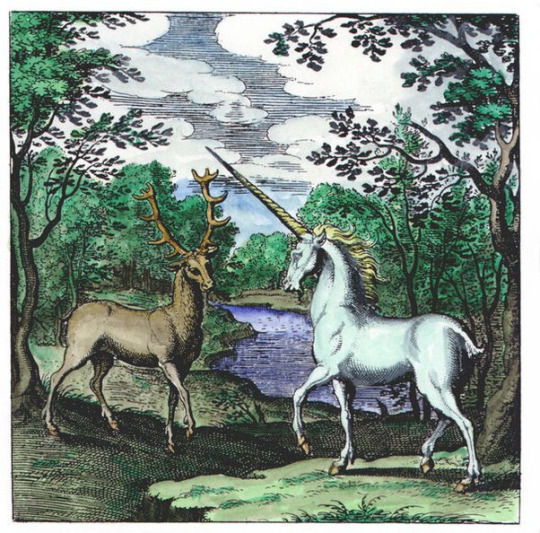
From The Lambspring
Urine: Mercurial water during the putrefaction stage, the universal solvent.
Venom: Alkahest — mercurial water at the beginning of the Opus, as a universal solvent that burns and destroys everything it comes into contact with. It “kills” the matter of the Stone during the nigredo stage, reducing it to prima materia. It is symbolized by venomous animals (or animals thought to be venomous) like snakes and toads. Also symbolized by the blood of the dragon or Green Lion. The venom is then transmuted into the water of life. Spiritually, this is a symbol of the psychological turmoil that you go through when you first become aware of your Shadow or lower self, which becomes a blessing once you overcome it. Self-awareness is painful at first, but is a means towards divine knowledge and purity. (also called vinegar)
Venus: Represents the metal copper, and the color green. She is the impure version of the Divine Feminine, just as Mars is the impure version of the Divine Masculine. She first appears as a “whore,” representing the impure matter of the Stone that quicksilver (a purer version of the Divine Feminine) must be extracted from. Mars and Venus are the alchemical couple before they become Sol and Luna. Sometimes she also presides over the Chemical Wedding and its results, wearing green. The matter of the Stone turns green just after the black nigredo and just before the rainbow Peacock’s Tail.
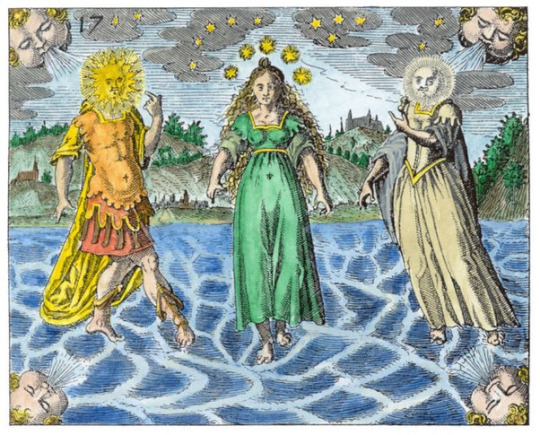
From Philosophia Reformata by Johann Daniel Mylius
Vessel: The flask or alembic in which the Philosopher’s Stone is made. Spiritually, it represents you – your body and consciousness. Your microcosm, in which the Great Work takes place.
Viper: The impure matter of the Stone at the beginning of the Opus, and also the mercurial spirit that is released from it when it is dissolved. It is poisonous and violent, because it has not been refined yet.
Virgin: The feminine aspect of Mercurius. Prima materia, which was “impregnated” by God to create the world, and generates all things. Also a symbol of argent vive (quicksilver), the cold and moist feminine principle. Represented by Diana (Artemis), the virgin huntress, who is also a symbol of the Moon (i.e. the Queen). Sapientia (wisdom) is also a form of the Virgin, this time representing the Philosopher’s Stone. In this aspect, she is a cosmic world-soul (similar to Hecate in the Chaldean Oracles). “Virgin’s milk” is the purifying and transforming form of mercurial water, and the White Tincture.
Vitriol: Sulfate, or sulfuric acid. “Green vitriol” (iron sulfate) is the impure matter of the Stone (i.e. the Green Lion), while “red vitriol” is purified sulfur.
Vulcan: Hephaestus, the smith of the gods, who is the archetypal alchemist in Paracelsian alchemy. This is probably because he works with metal and makes things out of gold. He also represents the “secret fire,” the purifying divine fire.
Vulture: The Bird of Hermes and a symbol for the entire alchemical process, because it is black, white, and red.
Water: The element, the essence of peace. Prima materia, primordial creation, chaos, darkness/the Abyss, philosophical mercury. It is cold and moist, and contains infinite possibility and creative potential, as well as volatile destruction. Also represents the Divine Feminine (i.e. the womb of creation). Symbolized by the Moon and quicksilver (mercury). In its destructive form, mercurial water is the universal solvent that reduces everything to prima materia, and then it transmutes into the purifying and revitalizing water of life.
Watering [plants]: Watering the philosophical tree symbolizes distillation and ablution, imbuing the body of the Stone with its spiritual essence.
Well: The vessel during dissolution, the container for the mercurial water. Another symbol for the baptismal bath or fountain.
White: The albedo, the second stage of alchemy, when the vapor from the dying matter of the Stone rises to the top of the alembic, and the dead body of the Stone is washed in the mercurial waters. The human soul is washed clean of its sins and sorrows at this stage, and is capable of receiving divine love and inspiration. It represents purity and the giving of new life. Symbolized by milk, white roses, lilies, silver, snow, the water of life, the Moon, the swan, the dove, and the Queen.
White Elixir: The White Stone in liquid form, an elixir with the power to transmute base metal into silver, obtained at the albedo stage. It can cleanse anything of its stains and purify matter into a near-perfect state. It is the milk that is “fed” to the baby Philosopher’s Stone during cibation. (Also called the White Tincture).
White Foliated Earth: The matter of the Stone in the albedo stage, which has decomposed, been purified, and become white fertile soil. The seed of gold is “planted” in it, so that the Stone will be able to transmute base metal into gold. The white earth is watered when the soul reunites with the body. Symbolized by ash, dust, salt, or snow, and Luna/the Queen.
White Stone: The matter of the Stone as it is during the albedo stage, able to transmute base metal into silver. It is the mundane body having become pure and spiritual through repeated refinement (distillation/sublimation). Symbolized by Luna, the White Queen.
Wind: The vapor at the top of the flask, Mercurius during the sublimation stage. It is the soul that contains the life-spark, “the wind shall carry it in its belly.” The Stone at its most subtle. Eventually, it condenses and turns to water, then falls back to Earth again. (Also called zephyr)
Wolf: Antimony. It devours the body of the King when he dies during the nigredo stage, symbolizing his destruction by the mercurial waters. Similar symbol to the Green Lion.
Womb: The vessel, in which the Stone is conceived. Also a symbol for the bath or fountain that cleanses the matter of the Stone, and a symbol for the white foliated earth in which the “seed” of metals grows. The earth is “impregnated” by the spiritualized soul, which condenses and falls to the earth. When this happens, the Stone is born.
Worm: Another symbol for the mercurial water and secret fire, that destroys and then revitalizes matter. Interchangeable with the serpent or dragon. It decomposes the dead body of the Stone during the putrefaction, eating away all corruption.
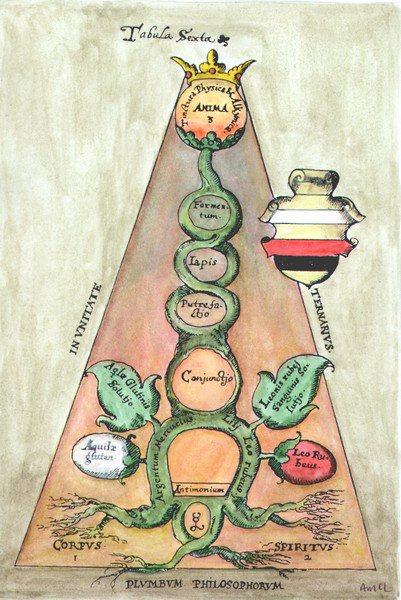
From The Marrow of Alchemy by George Ripley
#alchemy#alchemical symbols#alchemical symbolism#hermeticism#hermetic symbolism#alchemical#mercurius#occult#occultism#occult symbolism#dictionary#symbolism#symbol dictionary#philosopher's stone#long post
164 notes
·
View notes
Text
Persephone's Influence in My D1 and D9 Charts
Feeling literally blessed and just have to brag a little - all the aspects listed are under 3º, and a good chunk are 0-1º. These aren't even all of them because I can only check nine at a time and even recording all the ones on the chart would be too long to handle so a lot have been left aside... 🙏 Love you, my queen and one of my major patrons, Persephone.
NATAL: Persephone conjunct my Moon, trine my Mars, Pholus, and Praxedis, sextile Saturn, Aphrodite, and Nessus, and square Chiron, Ceres, and Juno. Proserpina trine Venus and Ketu, and quintile Cora. Hypothetical Proserpina conjunct Lilith, square Uranus, and opposite Sedna. Cora square Chiron and Juno, trine Agni, and quintile Lilith and Hypothetical Proserpina. Praxedis conjunct Mars and Pholus, trine Moon and Persephone, opposite Saturn and Aphrodite, sextile Nessus, and square Sun. Protogeneia trine Pluto. Ceres trine Sun and conjunct Minos. Demeter opposite Pluto. Zeus conjunct Jupiter and Pallas. Panacea conjunct Imum Coeli. Orcus conjunct Vesta and Rahu, opposite Venus, and trine Disa. Hypothetical Hades trine Venus. Haidea opposite Moon and Persephone, sextile Mars and Praxedis, trine Saturn, Aphrodite, and Nessus, and square Ceres. Hadano conjunct Mars, Pholus, and Praxedis, square Sun, and trine Moon. Polyxenos conjunct Antivertex and square Rahu. Summanus opposite Pars Fortunae. Hermes conjunct Venus and Ketu. Tisiphone conjunct Antivertex. Megaira conjunct Ceres and trine Sun. Ara conjunct Moon. Arai conjunct Chiron-Juno conjunction. Cerberus conjunct Nessus and quintile Medium Coeli. Deira conjunct Antivertex. Scylla conjunct Medium Coeli. Carpi conjunct Rahu. Iasus conjunct Antivertex. Kronos trine Moon and Mars, square Jupiter and Pallas, and opposite Nessus. Moira conjunct Medium Coeli. Atropos conjunct Rahu, and opposite Moon. Morpheus conjunct Uranus. Hypnos conjunct Vesta, and opposite Venus. Mors-Somnus conjunct Jupiter and Pallas. Tantalus conjunct Moon and Persephone. Eurydike conjunct Ascendant and trine Medium Coeli and Orpheus. Orpheus trine Eurydike and Ascendant and conjunct Medium Coeli.
NAVAMSA: Persephone trine Jupiter, Neptune, Rahu, Pallas and Hypothetical Proserpina and square Vesta and Medium Coeli. Proserpina conjunct my Chiron and Juno conjunction. Hypothetical Proserpina conjunct my Neptune and Rahu conjunction, and trine Jupiter, Pallas, and Persephone. Cora trine Praxedis. Agni trine Sun, Ceres, Vesta, and Medium Coeli, square Rahu, and sextile Venus. Protogeneia conjunct Mercury and Pluto, and trine my Descendant. Ceres conjunct Sun. Demeter conjunct Uranus. Pluto conjunct Mercury, trine Descendant, and square Sun and Hermes. Panacea conjunct Descendant. Orcus trine Vertex. Haidea-Summanus conjunction conjunct Saturn, opposite Mars, and trine Antivertex. Hadano trine Jupiter, Neptune, Persephone, and Hypothetical Proserpina. Minos square Moon, Mars, and Saturn. Cerberus square Ascendant. Gaea conjunct Neptune. Kronos opposite Saturn and quintile Imum Coeli. Moira conjunct Ascendant. Klotho conjunct Descendant and trine Mercury and Pluto. Lachesis opposite Chiron and Juno. Atropos conjunct Lilith. Morpheus trine Moon and Mars. Hypnos quintile Pluto. Mors-Somnus conjunct Jupiter and Pallas. Lampos conjunct Saturn. Orpheus trine Chiron, Juno, and Nessus.
Okay, I'll leave it be and get back to actual posts but my point is that I literally am so full of love for my primary patron, the literal original Maiden. May Persephone grant you a blessed rebirth. ♡
#astrology#persephone#asteroids#underworld#this isn't a post about how she loves me more than others just that she and I get each other okay ♡#mine#authored#about me
11 notes
·
View notes
Text
Gallifreyan Great Houses & Members (Part 2 - Newblood Houses)
Check out Part 1 - Oldblood Houses
Newblood is a term for Time Lords of newer houses. Newblood’s are loomed with two hearts and have better rebirth control than the older houses. They view regeneration as trivial. Newblood Houses were more likely to produce interventionists, and some even viewed time-active cultures as not being lesser species; for these reasons, they were often viewed by Oldbloods as smug and ambitious, accepting diversity rather than conformity. (from Faction Paradox: The Book of the War & Virgin New Adventures: Christmas on a Rational Planet.)
[ NEWBLOOD HOUSES ]
DEEPTREE (from Big Finish Gallifrey Audio: Lies)
The House that Andred belonged to in the Gallifrey Audios.
MEMBERS:
Andred
_________________________________________
DVORA (aka HOUSE OF DEVOURING HOUNDS) (from Faction Paradox: The Book of the War, Faction Paradox: Newtons Sleep, Faction Paradox: De Umbris Idearum, Faction Paradox: A Farewell to Arms, & Big Finish Gallifrey Audio: Panacea)
One of the six ruling houses during the War in Heaven and the First Newblood house after the Imperator crisis. A tribal, ‘Alpha Male’ type house. Never shies away from using force. Gained an enviable reputation for eminence. Dvora is renowned for being practical, efficient and unstoppable. An emblem of controlled, concerted, voracious power. The most powerful Newblood house on Gallifrey and the house that exercises the greatest real power. Considered far more stable than the other Newblood houses. The Prydonian Chapter was reduced to a servitor of House Dvora. The “Devouring Hounds” title referred to the controlled dominance of a pack leader rather than the wild savagery of the followers.
Dvora members are described as being: “Neither gauche nor hidebound, the members of House Dvora look out across the landscape of the Homeworld from the comfortable position of an established pack predator. They are not careless, They are sombre, they are sane, they are pre-eminently practical. What they grip, they hold. When not deployed in the field their personas are icy, untouchable and ironic, but they can when necessary, adopt any passion.”
MEMBERS:
Romanadvoratrelundar (Romana)
The Imperator (Morbius)
Thessalia
The War King
Larissa
Seven elite operatives
_____________________________________
HEARTSHAVEN (from Big Finish Gallifrey Audios: Panacea & Annihilation and Big Finish Doctor Who Audios: Neverland and Erasure)
A Prydonian house and family home of Romana. When Romana returned to it following the Gallifreyan Civil War, she found it abandoned and infested by pig-rats. While living at Heartshaven, Romana had a Pig-Bear servant and was an only child. The house was located far from Mount Lung. It had a well stocked wine cellar which was fortified to protect it in the case of earthquake.
MEMBERS:
Romanadvoratrelundar (Romana)
____________________________________
JURISPRUDENCE (from Big Finish Gallifrey Audio: Insurgency)
A great house that Inquisitor Darkel belonged to. Jurisprudence is the study and theory of law.
MEMBERS:
Inquisitor Darkel
______________________________________
LOLITA (from Faction Paradox: The Book of the War, Faction Paradox: The Year of the Cat, Virgin Bernice Summerfield New Adventures Novel: Dead Romance, Faction Paradox: The Brakespeare Voyage, and Faction Paradox: The Shadow Play)
A house founded by Lolita during the War in Heaven. Initially, she was the only member and reserved all places for her future children who were timeships just like her. Originally allied with House Tracolix and the Sontarans, House Lolita betrayed them both when it destroyed the Eleven-Day Empire. Bolstered by its defeat of Faction Paradox, House Lolita gained enough prestige and political power to receive approval for making changes to 18th century history. Lolita predicted that the final confrontation between House Lolita and the survivors of Faction Paradox would take place in that time period.
MEMBERS:
Lolita (Creator/Named after)
___________________________________
OAKDOWN (from BBC Past Doctor Adventures: Divded Loyalties)
A Prydonian house and a respectable house known for producing the Master.
MEMBERS:
The Master
__________________________________
PARADOX (from BBC Eighth Doctor Adventures Novels: Alien Bodies, Unnatural History, Interference, The Ancestor Cell, The Adventuress of Henrietta Street, The Gallifrey Chronicles and especially the Faction Paradox Series.)
Once known as House Paradox, Faction Paradox was a time-active cult and criminal syndicate devoted to opposing the Time Lord’s traditional philosophy of rationality and stability over time travel. They were founded by Grandfather Paradox as a renegade house and inducted members of lesser species into their ranks. They played a neutral role. The House was unpopular for their penchant for death fetishism (which mocked the Great Houses' pretension of immortality) and due to members' use of familial terms like "Grandfather" (disdainful, since the Great Houses had been made sterile by the anchoring of the thread). Most offensive, though, was the House's open interest in perverting the Web of Time.
MEMBERS:
Grandfather Paradox (Creator/Founder)
Fitz Kreiner
Justine McManus
Christine Summerfield aka Eliza
Grandfather Morlock
Mother Mathara
Aaron Blinovitch
Michael Brookhaven
__________________________________
RASSILON (from Big Finish Gallifrey Audio: Desperate Measures)
A great house containing the lineage of Rassilon himself.
MEMBERS:
Rassilon (supposed founder/creator)
Valerian
__________________________________
REDLOOMS (from Virgin New Adventures: Lungbarrow & BBC Eighth Doctor Adventures: The Taking of Planet 5)
Also known as Redloom. Its members were noted for being inquisitive as well as for their initiative and being in the Chancellery Guard.
MEMBERS:
Hilred
Andred
Redred
Leela (as Andred’s wife)
Holsred
Redloom
_________________________________
TRACOLIX (from BBC Eighth Doctor Adventures: Alien Bodies, Faction Paradox: The Book of the War, The Eleven Day Empire, The Shadow Play, & The Brakespeare Voyage)
An ambitious Newblood house arguably prone to recklessness and over-concern with fashion. The House was given to furthering its interests in the universe by employing agents from other species, which could range from elegant Dandies to Sontarans. By the time of the War in Heaven, Tracolix had risen to become one of the six ruling houses, alongside Xianthellipse, Arpexia, Dvora, Mirraflex and Lineacrux, filling the space in the social hierarchy that had previously been filled by the six houses; Arcalian, Cerulean, Dromeian, Patrex, Prydon and Scendeles.
MEMBERS:
Ruthven
_________________________________
URQUINEATH (from Faction Paradox: Weapons Grade Snake Oil)
A minor house officially known as the "maven house of inconsequence" and "holder of naught.” It was "one of the shittier Houseworld bloodlines.” The Hussar stole all of Urquineath's assets and gambled them away, causing the House to go bankrupt. Antigone, ashamed of the decline her House had gone through, renegaded to the newly-formed House Paradox. By the time of the War, Urquineath no longer existed and was almost completely forgotten. House Urquineath members had purple-flecked eyes.
MEMBERS:
Antigone
The Hussar
__________________________________
OTHER NEWBLOOD HOUSES WITH NO KNOWN MEMBERS:
MEDDHORAN (from Faction Paradox: Against Nature)
All its members had the house name in their names. Many of its members were seeded with biodata of lesser races, an experiment that their parent house, House Xianthellipse, considered a failure.
WETRIX (from Big Finish The Eighth Doctor Audio: The Conscript)
One of the great houses on Gallifrey.
#great houses#gallifreyan culture#doctor who lore#dweu#doctor who eu#faction paradox#time lords#gallifrey
55 notes
·
View notes
Text
"You want to know what death is? I'll tell you. Death is the loss of life. Despite everything doctors like me attempt... a patient's life can still fall through our fingers. You think death lies in the apex of science? Anyone with such little regard for life will die by my hand."
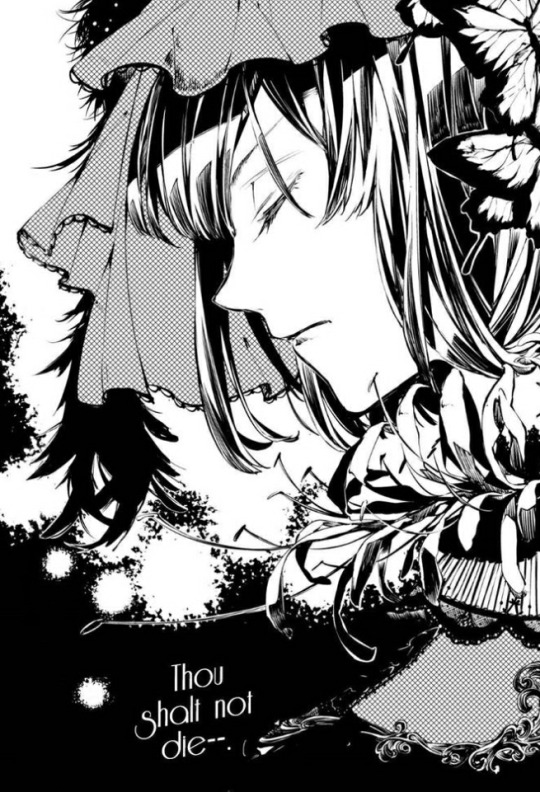
Character Analysis: Yosano Akiko
Age: 25 || Ability: Thou Shalt Not Die
BSD CHAPTER CHAPTER 65-66 SPOILERS
table of contents:
1. Author counterpart.
2. Yosano's history.
3. 'Angel of Death' defined.
4. Yosano and Atsushi.
YOSANO BRAINROT!*(#&!*@#($
1. Author counterpart.
Having been given the “Sho Ho” at birth, Yosano Akiko’s counterpart—the real-life author—was known for her zealous take on both feminism and pacifism.
Side note: Once again, to avoid confusion, I will use the name Sho Ho in reference to the real-life author, and Yosano in reference to the BSD character.
Sho Ho's writings were pretty much out-of-the-ordinary in her time, and despite being suppressed by the social norms of gender hierarchy, she sought to reform society’s view on the cultural perspectives of women and their sexuality (She expressed her love for a woman in one of her poems, but many still argued on whether she identified herself as queer or not.)
"Thou Shalt Not Die," Yosano's ability, is actually named after one of Sho Ho's most famous, controversial poems. She wrote it for her brother, who was a soldier in the war between Russia and Japan (1904-1905). In her poem, she expressed her general distaste for war and how her brother was a part of it.
O my young brother, I cry for you Don't you understand you must not die! You who were born the last of all Command a special store of parents' love
Would parents place a blade in children's hands
Teaching them to murder other men Teaching them to kill and then to die? Have you so learned and grown to twenty-four?
- excerpt from Sho Ho's poem, "Kimi Shinitamou Koto Nakare"
Her words were blunt enough to inflict guilt on her brother's conscience, as she wasn't afraid to express her disapproval over how her brother took part in the typical violent bloodshed and manslaughter of war. Such opinions perturbed the authorities, and her work was eventually banned from the public for a period of time. Later on, it was used as an anti-war statement.
2. Yosano's history.
Now, as for the character in BSD, Yosano is seen to be generally strong-willed, and later on, we see that she is terrifyingly compassionately ambitious in the way she treats her patients. She treasured life itself, and hated the thought of losing a patient.
Yosano had developed her relations with Mori Ougai back in the Great War, when she was just 11 years old. Her ability was a great benefactor in saving lives. Realistically speaking, she was used for her ability to heal injured soldiers and diminish the effect of any casualty acquired.
Initially, she wasn't aware of this, until one of her close friends pointed it out by subtly accusing Mori of manipulating her to participate in the War under the close-to false pretence of 'saving lives.'
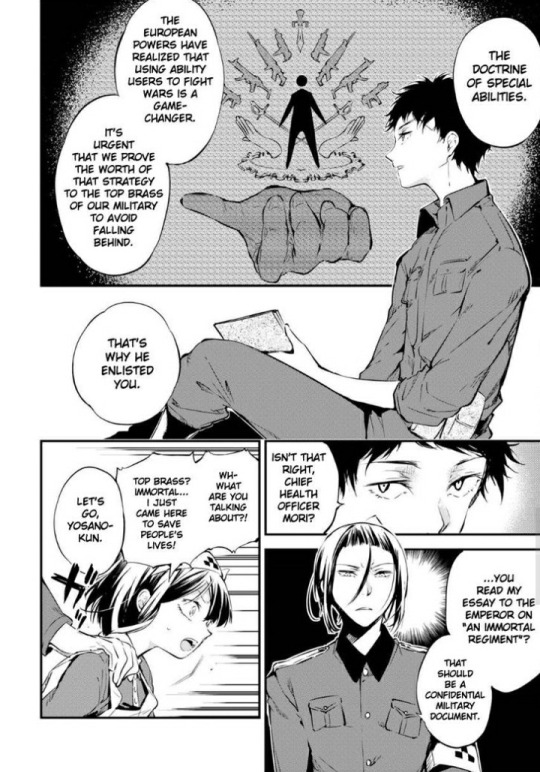
As much as her ability did save lives, it also forced soldiers to return to the frontlines and suffer injuries over and over again. The soldiers were never given the opportunity to return to their families because of her ability. This obliged them to carry on in the war without any excuse, inserting them into a vicious cycle they had no escape out of.
Metaphorically speaking, Yosano's hatred for Mori sort of mirrors Sho Ho's disdain for war and fighting, don't you think? The way Kafka materialised Yosano's past was quite interesting because he used chapters 65 and 66 to explain Yosano's dislike for Mori, reflecting how Sho Ho used her poem to explain why she condemned the idea of war and how her brother was part of it.
Before the effect of her ability was fully understood, however, every soldier praised and thanked her for what an angel she was. One of the soldiers she had befriended and gotten close to even kept a tally of the number of times she had saved him. He was the one who gifted her the butterfly hairpin she wore all the time.
The weight of the truth that her ability was a curse rather than a blessing fully dawned on her when her soldier friend ultimately committed suicide, because the fact of being indefinitely trapped in the throes of war agonised him until his spirit gave out. This drove Yosano to loathe her ability, or rather, how it was used.
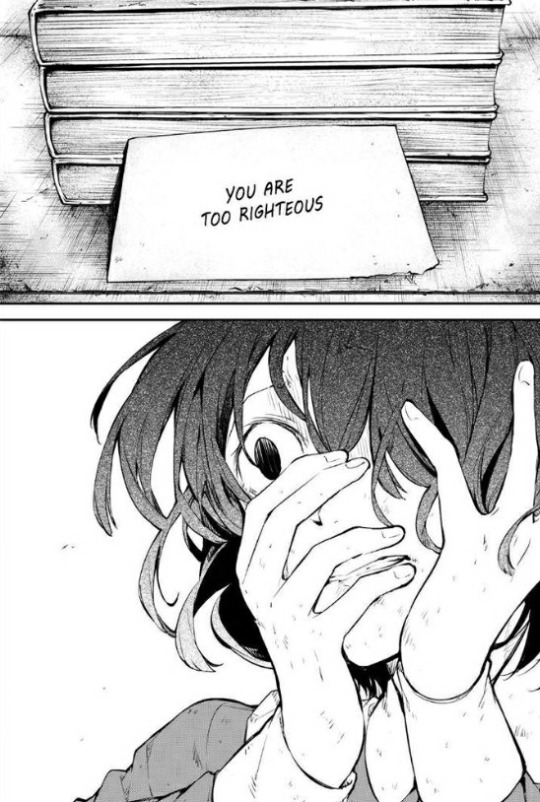
In the time she participated in the War, Yosano was given the alias 'angel of death' due to the control she retained over the battlefield, but I thought that perhaps Kafka had a reason behind giving her this title, so I did my research.
3. 'Angel of Death' defined.
Side note: I wouldn't want to disrespect any culture or religion, so if my citations are inaccurate and/or disrespectful, do feel free to correct me/let me know! I did research out of pure curiosity, and I don't intend to twist the significance of any of the interpretations.
I had to grow up learning about the basics of religious stuff, so it's kind of nice to study something out of the box, and very much against my father's rigid belief system :D
ARCHANGEL ARIEL
(archangel: an angel of higher rank)
I came across the few characteristics of angels/goddesses and their roles, and the one which really caught my attention was the female archangel, Ariel, the angel of nature.
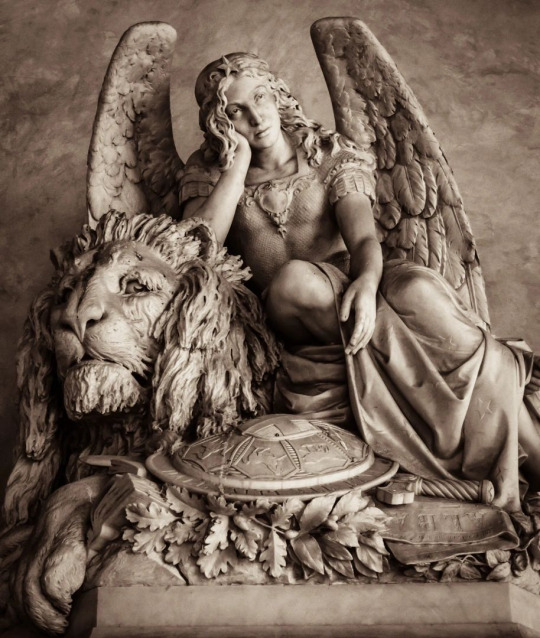
[ source ]
In Hebrew, the name Ariel means 'altar' or 'lioness of God,' and her role is to heal. In addition to that, she is also recognised as a helper to another one of the seven main archangels, Raphael, whose role is to provide physical and emotional healing, too.
She is the protecter of the environment and the animals therein, and is bestowed with the duty to oversee the order of heavenly bodies as well as earth's natural resources. She assures the sustenance of food, water, shelter, and supplies of human beings, much like how a nurse is to a patient I suppose.
In relation to Yosano, I think this part is pretty self-explanatory, or perhaps this is blown out of proportion HA, so take this as a suggestion rather than a fact, because I'd like to believe that Kafka had a reason for giving Yosano a title as such.
In the past, I've come across the angel of death only to perceive it as a female grim reaper of some sort, so it was pretty cool to find that the word 'angel' and 'death' made up a title of a someone like Ariel, one of the purest forms of humility and compassion.
GREEK GODDESS PANAKEIA
For my beloved (wannabe/or not) students of Greek mythology (much like myself, let's make a cult!), you've probably heard of Panakeia, the goddess of healing. Medicine finds most of its vital significance in Greek history, and in its mythology, Panakeia is actually known for her ability to heal any kind of sickness.
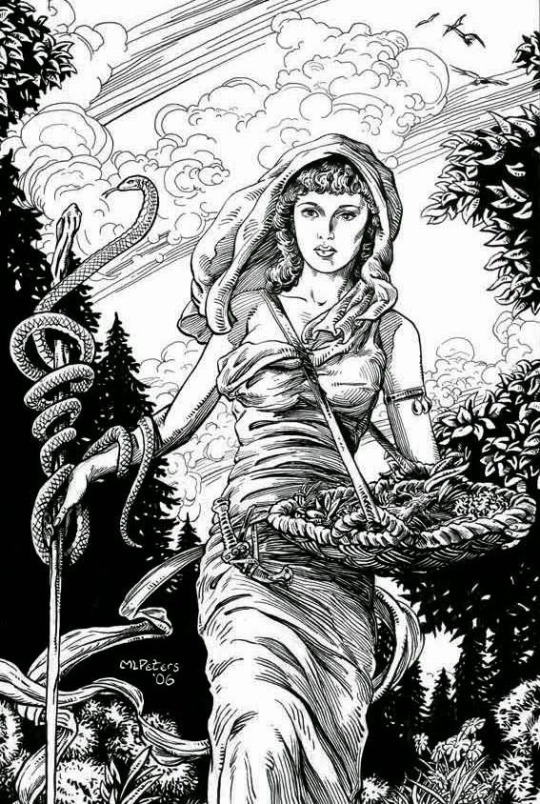
[ source ]
Her name means 'panacea,' which is actually defined as a remedy for all diseases. Terminal diseases and injuries lead to death, right? This would bring us back to Yosano's ability to nullify any injury's effects on a person, keeping them from death itself.
Now, we know that in order for Yosano's ability to work, her patient, or victim, has to be in a near-death condition in order for her treatment to take effect. This can't exactly fit into the description of resurrection, but it can be described as some sort of rebirth.
GREEK GODDESS PERSEPHONE
So another goddess which reminds me of Sho Ho/Yosano, is Persephone, the goddess of spring and rebirth. Before Hades, the god of the underworld, fell in love with Persephone to take her to live with him, Persephone lived a happy life.
Hades, with his nature of darkness and the like, was captivated by how pure Persephone was, and stole her away from her former life to live in an environment which differed sharply from her natural aura of purity.
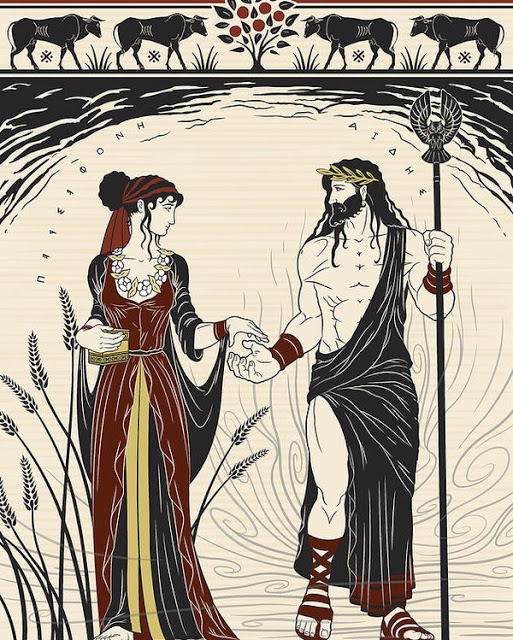
[ source ]
Remember when Yosano's friend left a note behind before he killed himself? The note said nothing except for, "You are too righteous." Take that as you will, but figuratively speaking, you could say Mori takes the role of Hades in the story, while Yosano can be portrayed as Persephone.
Sho Ho can also be a parallel of Persephone, in that she had to adapt to the realities of war and disharmony, while Persephone had to adapt to the raw darkness of the underworld with Hades.
Sho Ho stood against society's norms and decided to reform it, making her one of the most well-known feministic pacifist in history, while Persephone managed to escape from the underworld to return to her former position, earning the title the 'Bringer of Life,' or the 'Destroyer of Death.'
Furthermore, the way Sho Ho's anti-war poem took its effect later on, reflects the way Persephone restored balance in the world after returning from the underworld.
4. Yosano and Atsushi.
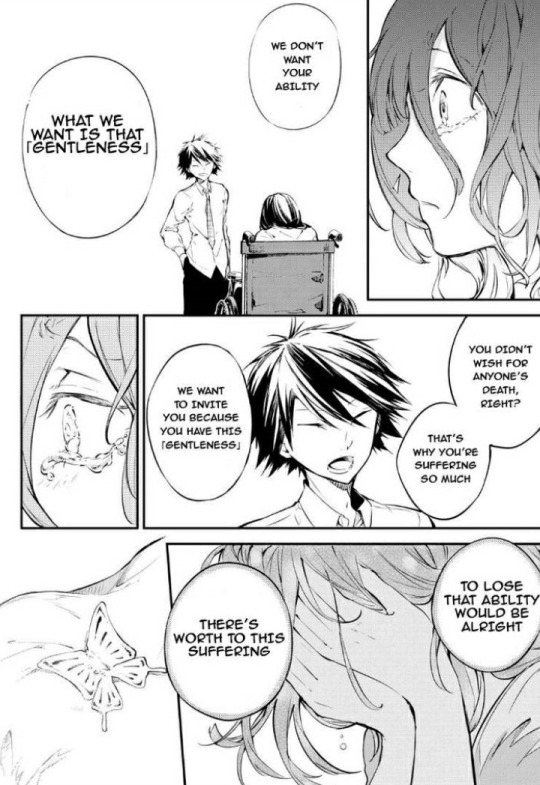
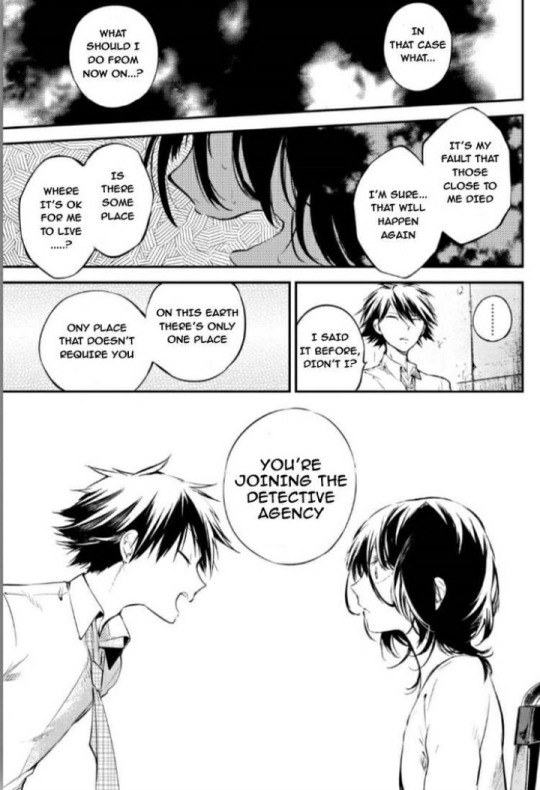
chapter 66; Yosano: "It's my fault that those close to me died... Is there some place where it's okay for me to live?"
chapter 8; Atsushi: "If I have any chance of saving them all, of returning them home safely, would that mean it's okay for me to keep on living?"
I couldn't help but think of Dazai and Atsushi back when I was reading through these panels. Ranpo (my beloved), along with Fukuzawa, accepted Yosano as she was, despite how her ability was a cause of despair and misfortune.
Ranpo looked past her mistakes and the entirety of how dark her past was to welcome her into the Armed Detective Agency. Dazai, on the other hand, knew who Atsushi was and what his ability had made him do before anyone else, and still decided to provide a safe place for Atsushi to find his sense of belonging, journeying with him as he learned to use his ability properly.
For more info about Dazai and Atsushi's dynamic, you can check out the analysis I did for Dazai :D
Atsushi desired to save people to prove his right to live, while Yosano made her wish to achieve the recovery of all her patients the reason for her existence.
Others would prefer to accuse both Yosano and Atsushi of having a saviour complex, but the reason why they pursued to save people with utmost dedication, stems from the nature of what their past was like. You know the saying 'from broken to beautiful?' Yeah, it's something like that.
The way their pasts were written out gave them a desire to change, which was, I daresay, initiated by the people who took them in: Ranpo and Dazai. Their abilities were demonised because of how they were used, but once they broke from their abilities' effect over their lives, they honed their skills to control them for the right cause instead.
In a less cynical point of view, I believe both Yosano and Atsushi stood for what was right, and wanted nothing but to achieve peace and harmony in whatever way they could, even if it meant risking their own lives to save others.
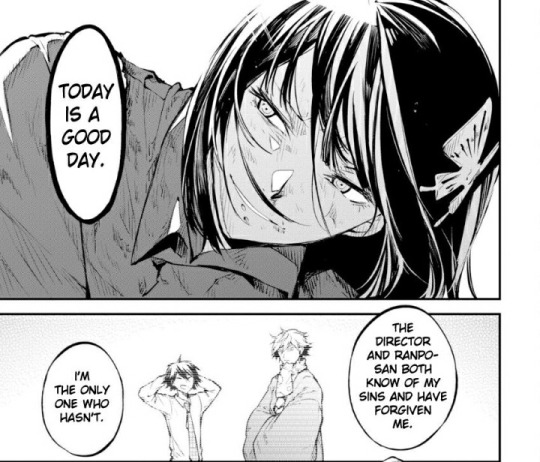
So yeah, that's it for my rants today. Thank you for reading, and if you have anything to add, go ahead! I'm open to discussions ;)
#bsd#bsd atsushi#bsd yosano#bungou stray dogs#bungo stray dogs#bsd characters#bsd analysis#literature analysis#bsd abilities#bsd anime#bsd manga#bungo stray dogs atsushi#bungou stray dogs atsushi#bungou stray dogs yosano#bsd dazai#bsd mori#bsd ranpo#character analysis#.daydreams
181 notes
·
View notes
Photo

—Sam Kriss, “It’s Not All in Your Head”
This essay cannily begins with perhaps the worst thing Freud ever did just to get it out of the way, pointedly juxtaposes his abandonment of “the seduction hypothesis” with the Satanic panic, and then—in an argumentative coup—recovers the legitimacy of demonic possession as a concept cognate to the return of the repressed.
I regularly mock conservatives for making an indigestible soup of the past in all its heterogeneity, but differences do recede to reveal hidden points of agreement the further away we get in time from bygone ideological conflicts. Christians whose forebears might have recoiled from what they would have construed—to be brutally frank—as Freud’s “Jewish science” can now welcome the doctor into the fold as one whose enlightened conservatism resembles Christian self-possession and whose clinical practice was somewhere between the act of contrition and the rite of exorcism—all this in preference to the contemporary world with its possibly excessive faith in mechanical explanations and panaceas, as if we were bots in need of an adjustment rather than souls requiring pastoral care. In that way the essay is an allegory of itself, of Sam Kriss publishing in First Things and all the attendant ironies on both sides of the transaction.
(I should read much more Freud, though I read quite a bit earlier in my life. In the only thing I’ve written about him, a seven-year-old brief essay on Beyond the Pleasure Principle, I hail him as “Doctor/Father Freud, the last Abrahamic patriarch, the last priest of Apollo, our last defender, albeit disguised as mere scientist, of Hebraic and Hellenic idealism both.” Grandiose!)
One point of disagreement about irony: Kriss rescues his dissatisfied reading of Tao Lin’s Leave Society by construing the novel as ironic in spite of itself, Lin’s unwitting testimony that his cure is as bad as his disease. I would locate the irony instead at the level of form, as I suggest in my essay on the novel: the real cure is that Lin finally has finally started writing prose that isn’t minimalist to the point of desiccation. His vision of the world has come alive in flashes of effulgence, which stylistic rebirth, more than ingesting this substance or refusing that, represents the minimal triumph Freud promised: where it was, I shall be.
5 notes
·
View notes
Text
HP Fests: Mad Frankenstein Fest 2020
July - September 2020:
All Mixed Up by Pargcool - G, one-shot - You’ve got to be kidding me. Hermione froze, her eyes fixed on the back of the man wiping down the bar counter. Lydia—according to her name tag—didn’t seem to notice her sudden lack of attention and continued her introductory spiel. The words faded into the background, Hermione’s gaze narrowing on the back of the bartender’s head. She’d only seen that bright platinum hair once before, but surely it was just a coincidence. What the hell would Draco Malfoy be doing in a random muggle bar?
Architectural Symmetry by MissELY, Wolfqng - T, one-shot - Draco Malfoy hadn't planned on setting foot in Malfoy Manor ever again. Maybe to set it on fire. So when he and his curse-breaking partner, Hermione Granger, were assigned to go there he dashed off a response to their supervisor "Under no circumstances will we take this bloody assignment, are you out of your mind? -DLM" Hermione, however, had other ideas
Breaking the wall by DaniiiAnn, VGinny - T, one-shot - The prompt was Healers or Co-workers at St Mungo's. It's seven years since the war, Draco is a speciality Healer and Hermione is his Solicitor. His experimental healing has put his career and the hospital in trouble. Would Hermione be able to help the former enemy get out of trouble?
Chrysopoeia by hiyas, monsterleadmehome - T, one-shot - Hermione Granger and Draco Malfoy both have their personal reasons for studying Alchemy, but when they decide to work together to develop a new Panacea, they discover more than they bargained for.
Cuando Pienso en Ti by LilithShade, TakingFlight48 - E, one-shot - Giving back to the magical community with her flourishing Philanthropic organization, Rennervate, would have been much simpler if Draco Malfoy would just leave Hermione Granger alone. It's time Draco learned that the Rumba was a dance for two, because although each encounter increased the heated passion between the two of them, Hermione will walk away if he cannot change his playboy ways.
Feint of Heart by Aneiria, hiyas - E, 3 Chapters - ‘Want to make this interesting, Granger?’ Draco said. His voice was low and dangerous and sent a delightful shiver down Hermione’s spine. She forced herself to focus on his words, not how he was saying them. ‘What do you mean?’ Hermione asked warily, not dropping her wand. ‘Winner gets a favour granted by the loser.’ Hermione scoffed. ‘I’m not giving you carte blanche like that, Malfoy.’ Draco watched her with his trademark cunning behind his silver eyes. ‘Alright then. How about a kiss?’
Mandatory Electives by DracosQuill, PhoenixDragon111 (Phoenix_Dragon) - M, one-shot - Hermione and Draco are tasked with revamping Hogwarts’ Mandatory Elective curriculum. What will happen when they come together?
The Melody of Touch by magical_traveler - E, one-shot - One of Hermione Granger’s favorite things about playing in an orchestra was when the orchestra began to warm up on stage. Tonight, however, was a different story. The London Philharmonic and guest pianist, Draco Malfoy, were performing together in concert. The program was beautiful but Hermione halted at the fact she would have to sit on a stage and perform music with him. They would be making something together. But all she could think about was the way his fingers caressed the piano keys, and the fact her body knew what it felt like to be touched by those same fingers.
Nontrivial Pursuits by senlinyu, sleeplessai - M, one-shot - Draco had a plan: reach the end of his probation, get promoted, and finally ask Granger out. Unfortunately, as his supervisor in the Ministry Archive, Granger seemed to be resistant to all Draco’s ideas on principle. The last thing he expected her to go along with was a trivia strip competition, and yet, somehow, here they were. “Do you have to?” Granger’s voice was sharp and jumped slightly at the last syllable. Draco glanced up and found that she was staring at him, the hollows of her cheeks a faint pink. He unfastened the cuff on his left sleeve without looking down and watched the pink transform into a stunning shade of red as he folded the fabric up to his elbow. She sucked her lower lip into her mouth and bit down on it visibly. “Have to what?” he said with a lazy grin. She made an incomprehensible noise somewhere in the base of her throat and looked away. “You’ll be losing your shirt soon enough anyway, I don’t know why you need to bother rolling up your sleeves.”
A Promise To Please by hslades, mia_moriarty - E, one-shot - Hermione Granger was great at most things, as such it didn't come as a surprise she was a great Quidditch Commentator. However, after her All-Star Seeker boyfriend, Draco Malfoy gets gravely injured in front of her eyes, she struggles to stay professional and keep their secret. Can Hermione keep her cool while trying to give Draco the healing touch he requires to overcome a grave injury? “You were wicked, love. I’d almost get injured again just so I could justify you retaking the reigns.” “Don’t!” She playfully slapped his chest, “Joke!”*slap* “About!” *slap* “Getting!”*slap* “Injured!”
Rebirth by elithien, senlinyu - M, one-shot - Granger will do almost anything to survive the curse slowly killing her, even if it means reawakening magic that has been dormant for a thousand years. Draco will do whatever it takes to save her “Draco...” she says again, fingertips fondly brushing across his cheekbone. He opens his eyes and finds her staring at him. “Before I do this, I want you to know—“ His heart lurches. “Don’t,” he says before she can say another word. “Don’t say it.” He catches her wrist and pulls her hand away from his face, careful not to smudge any of the words scripted across her skin. “I don’t want you to tell me.”
Roots & Recesses by ExpositorRevan (Naydras), simplifiedemotions - T, one-shot - “Her nephew working with the Mudblood to decommission her wand. Bellatrix must be rolling in her grave.”
Second Chances by PixieKisses - E, 2 Chapters - After years of working closely with Hermione Granger, Draco meets two children who end up changing his whole life.
Small Mercies by JessiRomantic, Kkpwnall - E, one-shot - Draco Malfoy had been working with Hermione Granger in the small bakery that occupied the ruins of the boathouse for eight years. For the last year, they have grown closer. But the 10th year anniversary of the battle racks up the tension to a new high.
A Turn of Phrase by AkaiaOwl, MissyJAnne85 - M, 4 Chapters - “A book deal? I thought the Malfoy inheritance guaranteed you wouldn’t have to work a day in your life.” “Do you write for money Granger?” She snorted at the ridiculous thought. “Of course not!” “Why do you assume I do?” he asked. A story about how Hermione Granger and Draco Malfoy turned the page after the war and found each other in the process. Written for the MF Fest - Dramione coworkers challenge. Prompt: Authors.
Tylwyth Teg - Fairies on a Welsh Mountain by Ernestin3, FedonCiadale - G, one-shot - Draco Malfoy, on probation in the department for the surveillance of magical creatures, is ordered by his boss, Luna Lovegood to collect tears from the elusive Welsh fairies for a much needed potion. Of all people, it is Hermione Granger, the witch from the Department of Law who is to come along. Will Draco finally be able to curb his tongue and tell her all the compliments that are in his head?
Unforeseen by ectoheart, riane_b13 - M, 2 Chapters - Hermione Granger was going to fail something for the first time in her life. Hermione Granger was going to fail something for the first time in her life and it was next to Draco Malfoy of all people. When she decided she wanted to become an Unspeakable she thought that it would take a lot of studying and hard work. She didn't think it would take a drawer full of leather, or a six-inch stiletto. Of course, Draco would be perfect at everything. Of course, everyone would love him. Of course, he would look positively sinful in everything he wore. It should be illegal for a man to look that good at seven in the morning. She needed a cup of coffee, she needed a stiff drink, she needed to get laid and she needed to pass these exams. Hermione Granger did not fail.
Ungentlemanly Behavior by MissELY, morticiahavisham - E, one-shot - After a tipsy hook up, Draco Malfoy has an apology to make. Hermione Granger would prefer not to hear it. But when they're forced to work together on a tricky translation, she's finds she can't avoid it.
Unyielding by Ernestin3, HeyJude19 - T, one-shot - Do you yield? She hated uttering that phrase whenever she bested Draco, but it was the standard protocol for ending a duel wherein both participants remained conscious. Hermione could count the instances on one hand in the four years they’d been partners that one of them had been Stunned. Do you yield? It clawed at her. It ate at her to demand this of another person when her own wand carried with it such a conceptually contrary and dubious description. Unyielding. No, not her own wand, she thought bitterly. The wand of Bellatrix Lestrange.
Your Latest Competition by ahoidraco, theheavycrown - T, one-shot - Hermione ventures into new professional waters after a career start at the Ministry, opening a shop in Wizarding London. Her café is well-received until it quickly becomes the target of Draco Malfoy's personal vendetta. If only Hermione knew why. Written for the July-September Mad Frankenstein Fest 2020.
112 notes
·
View notes